Financial Decision Making Report - FIN 7040, Autumn 2019, BPP Uni
VerifiedAdded on 2022/09/02
|23
|4663
|18
Report
AI Summary
This report provides a comprehensive analysis of financial decision-making within the UK coffee industry. It begins with an industry review, identifying key players like Costa and Starbucks, and highlights industry trends, opportunities, and threats. The report then delves into a business performance analysis, including a detailed examination of the statement of profit or loss, statement of financial position, and statement of cash flows, along with ratio analysis. The operating cash cycle is calculated and discussed. Further, the report explores dividend policy, investment appraisal techniques such as payback period, accounting rate of return, and net present value, along with management forecasts. Finally, the report discusses various sources of finance, their advantages and disadvantages, and concludes with references. The analysis includes a detailed look at the financial statements, performance metrics, and strategic considerations relevant to financial decision-making.
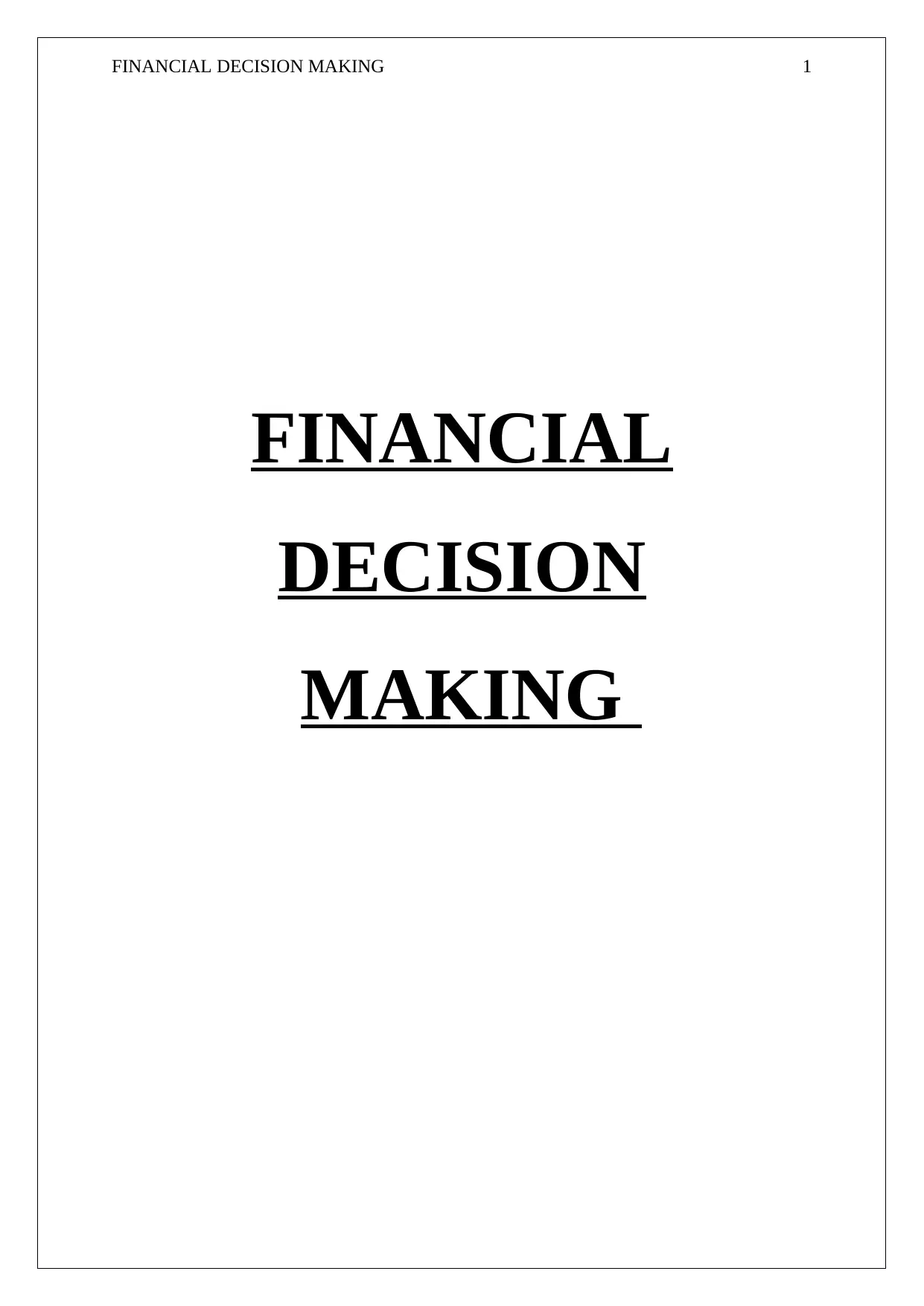
FINANCIAL DECISION MAKING 1
FINANCIAL
DECISION
MAKING
FINANCIAL
DECISION
MAKING
Secure Best Marks with AI Grader
Need help grading? Try our AI Grader for instant feedback on your assignments.
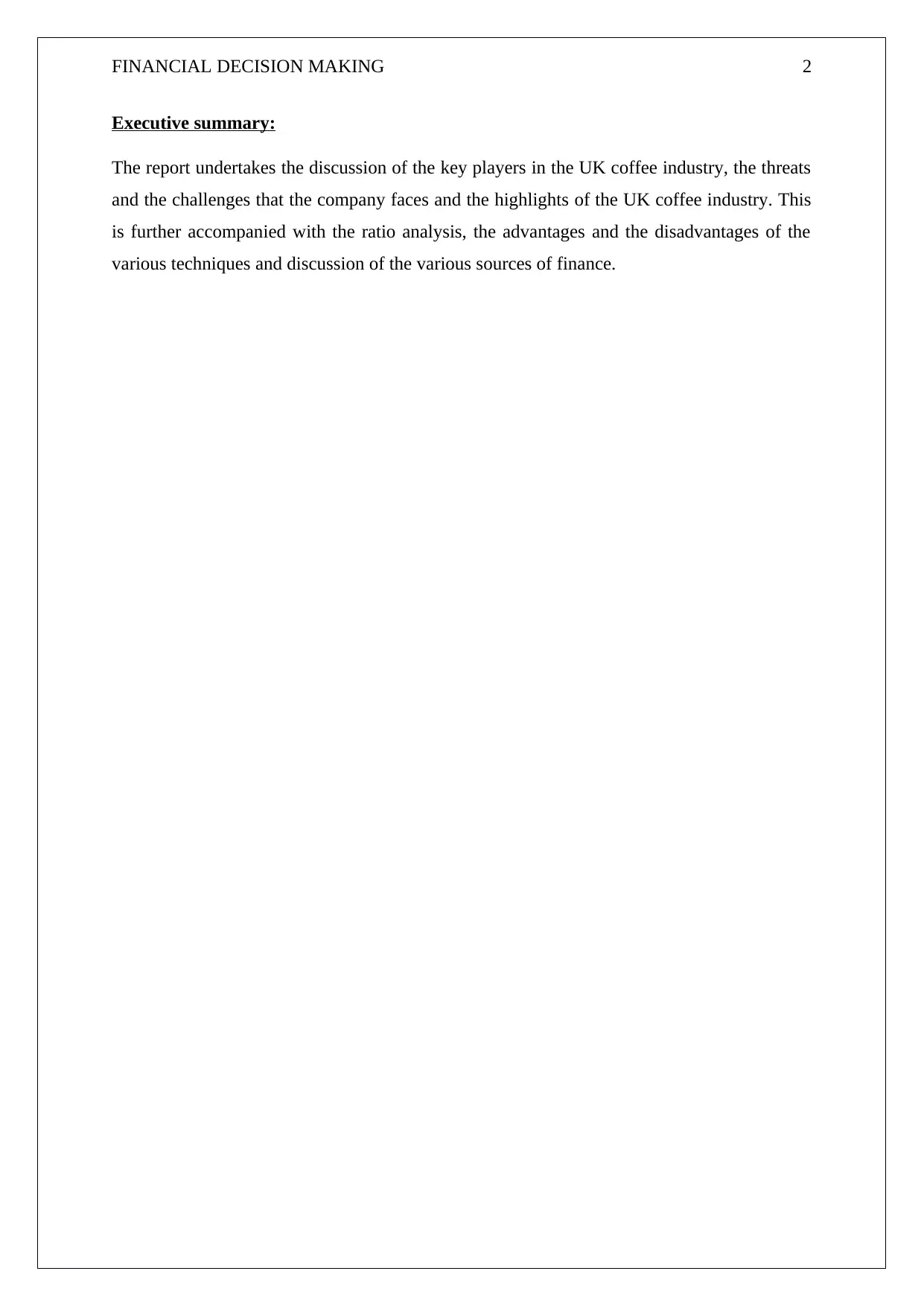
FINANCIAL DECISION MAKING 2
Executive summary:
The report undertakes the discussion of the key players in the UK coffee industry, the threats
and the challenges that the company faces and the highlights of the UK coffee industry. This
is further accompanied with the ratio analysis, the advantages and the disadvantages of the
various techniques and discussion of the various sources of finance.
Executive summary:
The report undertakes the discussion of the key players in the UK coffee industry, the threats
and the challenges that the company faces and the highlights of the UK coffee industry. This
is further accompanied with the ratio analysis, the advantages and the disadvantages of the
various techniques and discussion of the various sources of finance.
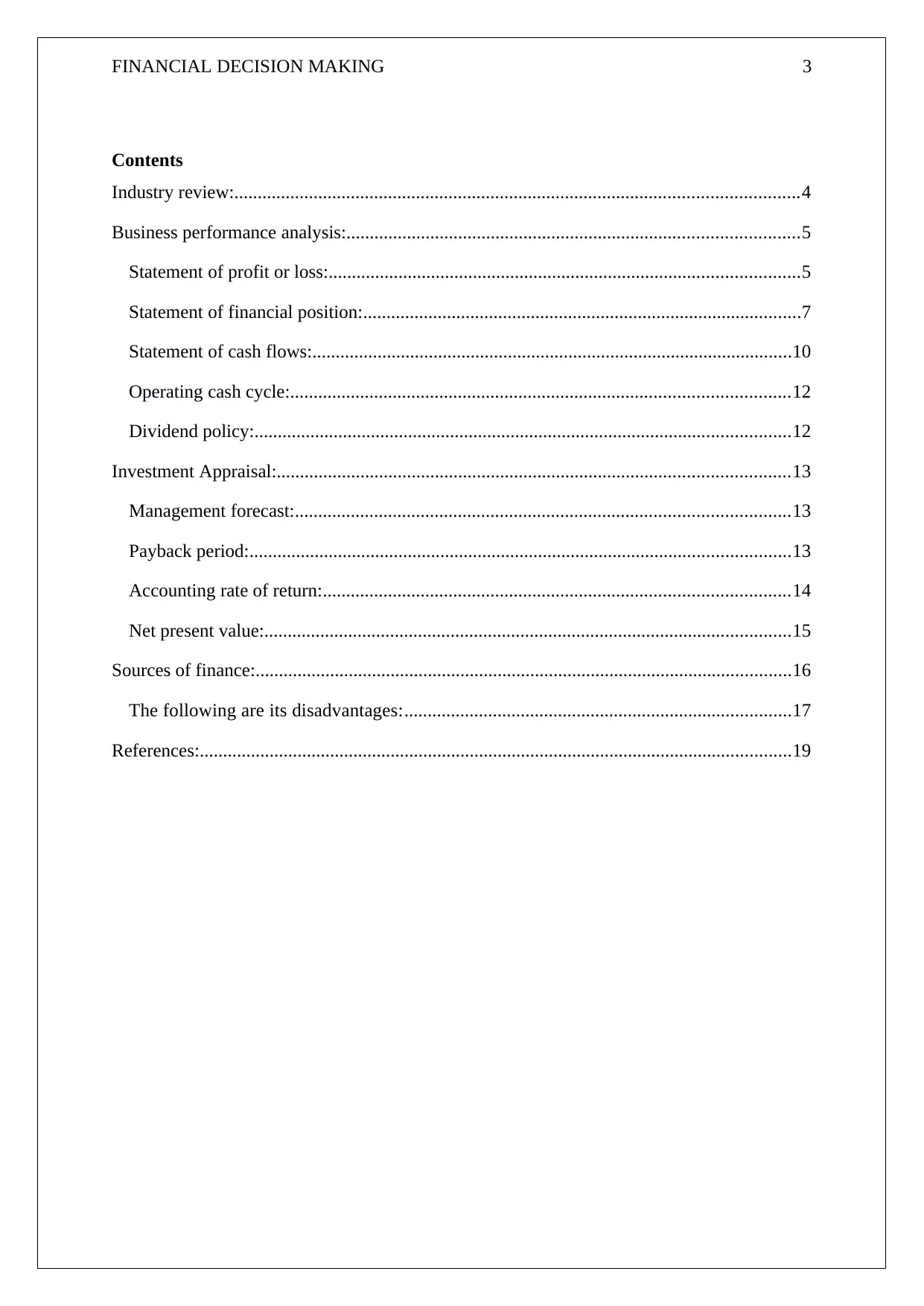
FINANCIAL DECISION MAKING 3
Contents
Industry review:.........................................................................................................................4
Business performance analysis:.................................................................................................5
Statement of profit or loss:.....................................................................................................5
Statement of financial position:..............................................................................................7
Statement of cash flows:.......................................................................................................10
Operating cash cycle:...........................................................................................................12
Dividend policy:...................................................................................................................12
Investment Appraisal:..............................................................................................................13
Management forecast:..........................................................................................................13
Payback period:....................................................................................................................13
Accounting rate of return:....................................................................................................14
Net present value:.................................................................................................................15
Sources of finance:...................................................................................................................16
The following are its disadvantages:...................................................................................17
References:...............................................................................................................................19
Contents
Industry review:.........................................................................................................................4
Business performance analysis:.................................................................................................5
Statement of profit or loss:.....................................................................................................5
Statement of financial position:..............................................................................................7
Statement of cash flows:.......................................................................................................10
Operating cash cycle:...........................................................................................................12
Dividend policy:...................................................................................................................12
Investment Appraisal:..............................................................................................................13
Management forecast:..........................................................................................................13
Payback period:....................................................................................................................13
Accounting rate of return:....................................................................................................14
Net present value:.................................................................................................................15
Sources of finance:...................................................................................................................16
The following are its disadvantages:...................................................................................17
References:...............................................................................................................................19
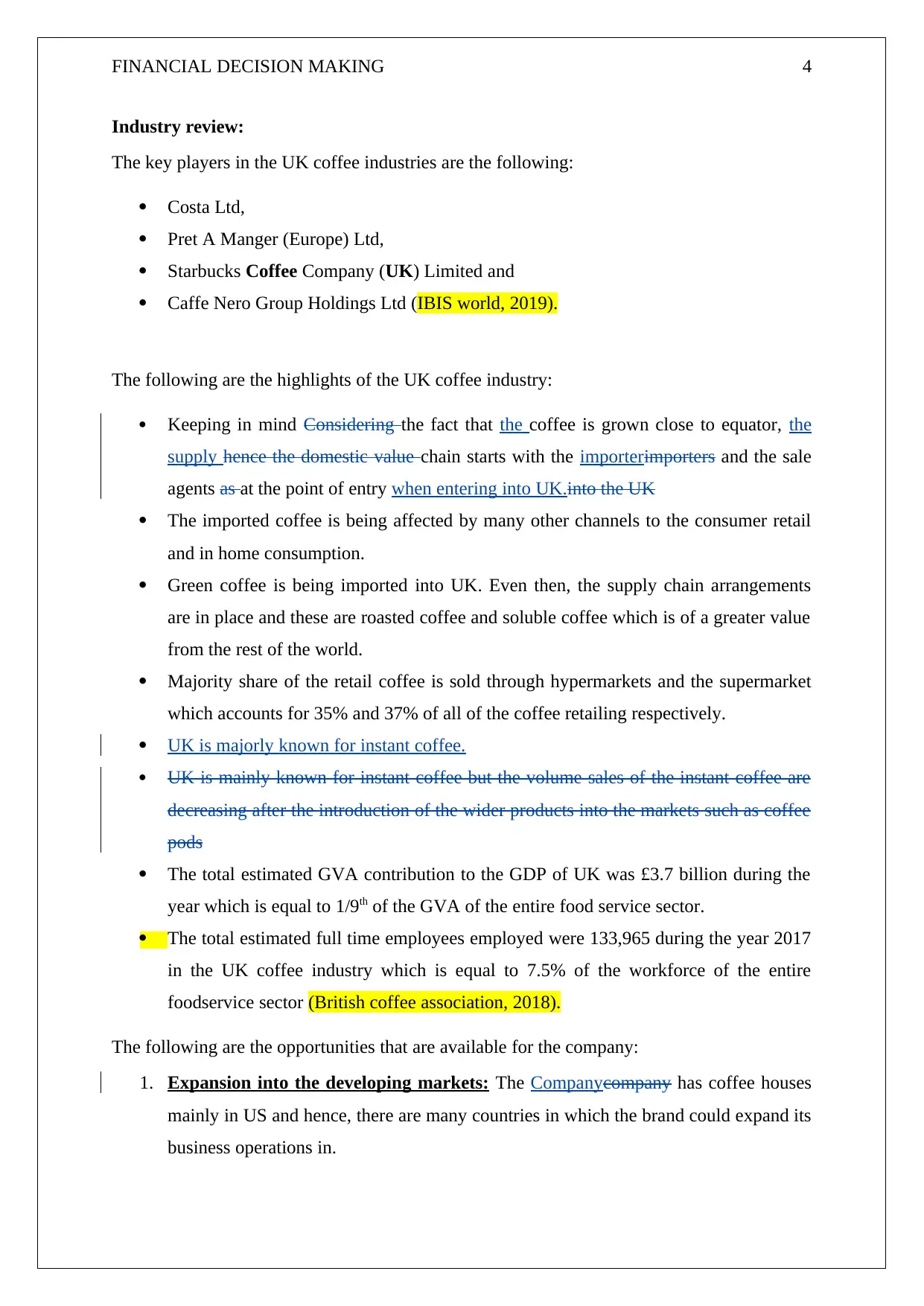
FINANCIAL DECISION MAKING 4
Industry review:
The key players in the UK coffee industries are the following:
Costa Ltd,
Pret A Manger (Europe) Ltd,
Starbucks Coffee Company (UK) Limited and
Caffe Nero Group Holdings Ltd (IBIS world, 2019).
The following are the highlights of the UK coffee industry:
Keeping in mind Considering the fact that the coffee is grown close to equator, the
supply hence the domestic value chain starts with the importerimporters and the sale
agents as at the point of entry when entering into UK.into the UK
The imported coffee is being affected by many other channels to the consumer retail
and in home consumption.
Green coffee is being imported into UK. Even then, the supply chain arrangements
are in place and these are roasted coffee and soluble coffee which is of a greater value
from the rest of the world.
Majority share of the retail coffee is sold through hypermarkets and the supermarket
which accounts for 35% and 37% of all of the coffee retailing respectively.
UK is majorly known for instant coffee.
UK is mainly known for instant coffee but the volume sales of the instant coffee are
decreasing after the introduction of the wider products into the markets such as coffee
pods
The total estimated GVA contribution to the GDP of UK was £3.7 billion during the
year which is equal to 1/9th of the GVA of the entire food service sector.
The total estimated full time employees employed were 133,965 during the year 2017
in the UK coffee industry which is equal to 7.5% of the workforce of the entire
foodservice sector (British coffee association, 2018).
The following are the opportunities that are available for the company:
1. Expansion into the developing markets: The Companycompany has coffee houses
mainly in US and hence, there are many countries in which the brand could expand its
business operations in.
Industry review:
The key players in the UK coffee industries are the following:
Costa Ltd,
Pret A Manger (Europe) Ltd,
Starbucks Coffee Company (UK) Limited and
Caffe Nero Group Holdings Ltd (IBIS world, 2019).
The following are the highlights of the UK coffee industry:
Keeping in mind Considering the fact that the coffee is grown close to equator, the
supply hence the domestic value chain starts with the importerimporters and the sale
agents as at the point of entry when entering into UK.into the UK
The imported coffee is being affected by many other channels to the consumer retail
and in home consumption.
Green coffee is being imported into UK. Even then, the supply chain arrangements
are in place and these are roasted coffee and soluble coffee which is of a greater value
from the rest of the world.
Majority share of the retail coffee is sold through hypermarkets and the supermarket
which accounts for 35% and 37% of all of the coffee retailing respectively.
UK is majorly known for instant coffee.
UK is mainly known for instant coffee but the volume sales of the instant coffee are
decreasing after the introduction of the wider products into the markets such as coffee
pods
The total estimated GVA contribution to the GDP of UK was £3.7 billion during the
year which is equal to 1/9th of the GVA of the entire food service sector.
The total estimated full time employees employed were 133,965 during the year 2017
in the UK coffee industry which is equal to 7.5% of the workforce of the entire
foodservice sector (British coffee association, 2018).
The following are the opportunities that are available for the company:
1. Expansion into the developing markets: The Companycompany has coffee houses
mainly in US and hence, there are many countries in which the brand could expand its
business operations in.
Secure Best Marks with AI Grader
Need help grading? Try our AI Grader for instant feedback on your assignments.
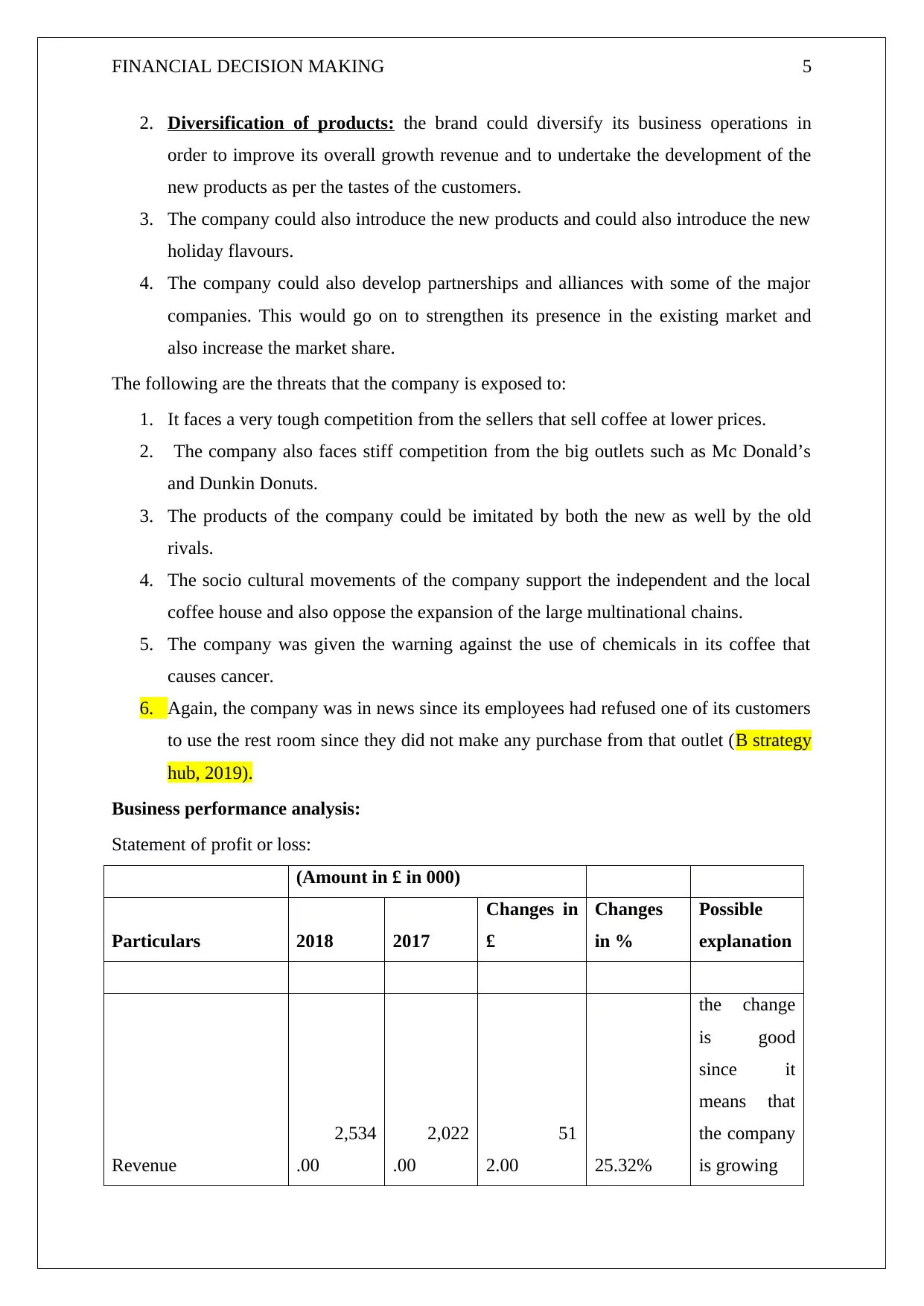
FINANCIAL DECISION MAKING 5
2. Diversification of products: the brand could diversify its business operations in
order to improve its overall growth revenue and to undertake the development of the
new products as per the tastes of the customers.
3. The company could also introduce the new products and could also introduce the new
holiday flavours.
4. The company could also develop partnerships and alliances with some of the major
companies. This would go on to strengthen its presence in the existing market and
also increase the market share.
The following are the threats that the company is exposed to:
1. It faces a very tough competition from the sellers that sell coffee at lower prices.
2. The company also faces stiff competition from the big outlets such as Mc Donald’s
and Dunkin Donuts.
3. The products of the company could be imitated by both the new as well by the old
rivals.
4. The socio cultural movements of the company support the independent and the local
coffee house and also oppose the expansion of the large multinational chains.
5. The company was given the warning against the use of chemicals in its coffee that
causes cancer.
6. Again, the company was in news since its employees had refused one of its customers
to use the rest room since they did not make any purchase from that outlet (B strategy
hub, 2019).
Business performance analysis:
Statement of profit or loss:
(Amount in £ in 000)
Particulars 2018 2017
Changes in
£
Changes
in %
Possible
explanation
Revenue
2,534
.00
2,022
.00
51
2.00 25.32%
the change
is good
since it
means that
the company
is growing
2. Diversification of products: the brand could diversify its business operations in
order to improve its overall growth revenue and to undertake the development of the
new products as per the tastes of the customers.
3. The company could also introduce the new products and could also introduce the new
holiday flavours.
4. The company could also develop partnerships and alliances with some of the major
companies. This would go on to strengthen its presence in the existing market and
also increase the market share.
The following are the threats that the company is exposed to:
1. It faces a very tough competition from the sellers that sell coffee at lower prices.
2. The company also faces stiff competition from the big outlets such as Mc Donald’s
and Dunkin Donuts.
3. The products of the company could be imitated by both the new as well by the old
rivals.
4. The socio cultural movements of the company support the independent and the local
coffee house and also oppose the expansion of the large multinational chains.
5. The company was given the warning against the use of chemicals in its coffee that
causes cancer.
6. Again, the company was in news since its employees had refused one of its customers
to use the rest room since they did not make any purchase from that outlet (B strategy
hub, 2019).
Business performance analysis:
Statement of profit or loss:
(Amount in £ in 000)
Particulars 2018 2017
Changes in
£
Changes
in %
Possible
explanation
Revenue
2,534
.00
2,022
.00
51
2.00 25.32%
the change
is good
since it
means that
the company
is growing
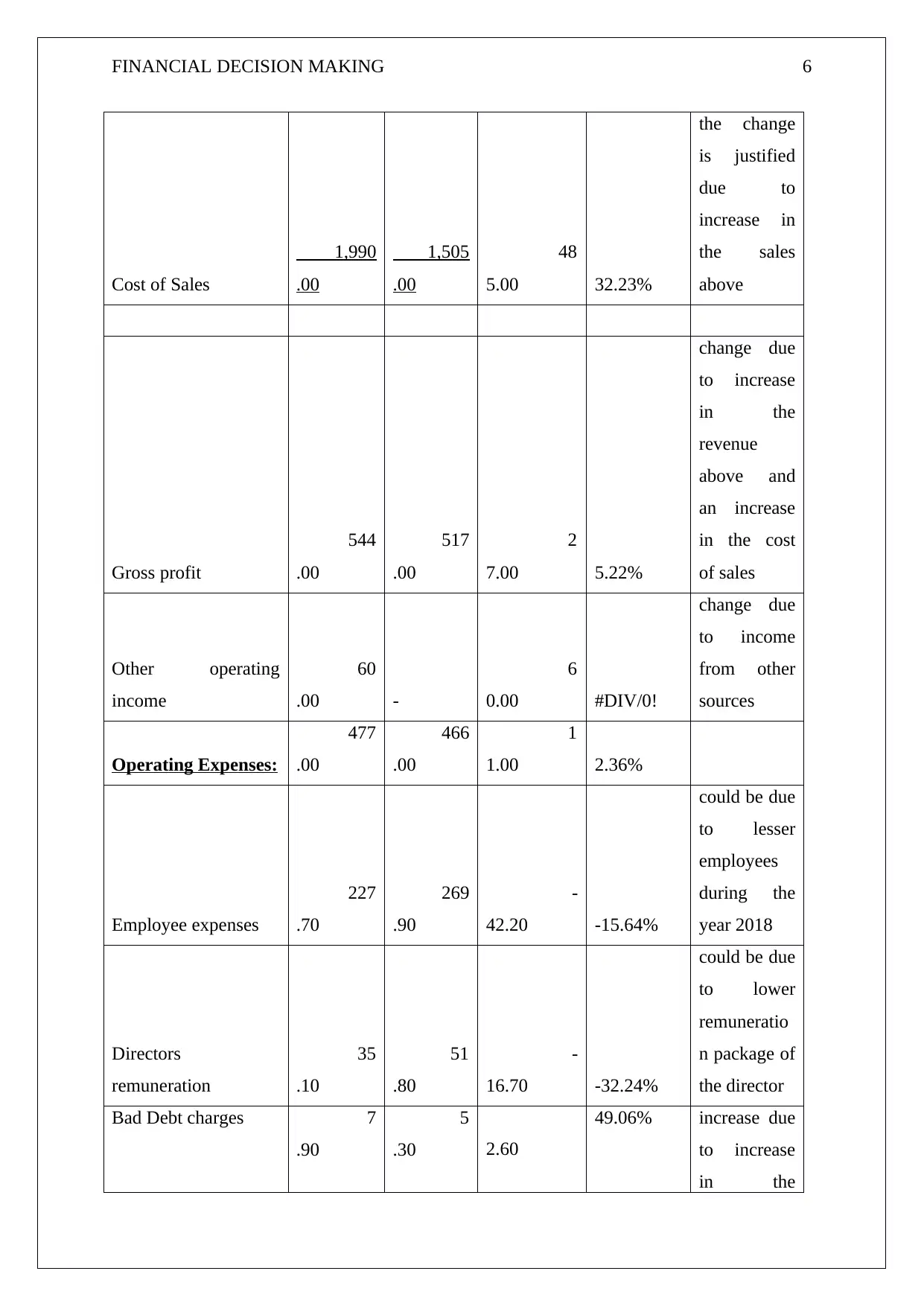
FINANCIAL DECISION MAKING 6
Cost of Sales
1,990
.00
1,505
.00
48
5.00 32.23%
the change
is justified
due to
increase in
the sales
above
Gross profit
544
.00
517
.00
2
7.00 5.22%
change due
to increase
in the
revenue
above and
an increase
in the cost
of sales
Other operating
income
60
.00 -
6
0.00 #DIV/0!
change due
to income
from other
sources
Operating Expenses:
477
.00
466
.00
1
1.00 2.36%
Employee expenses
227
.70
269
.90
-
42.20 -15.64%
could be due
to lesser
employees
during the
year 2018
Directors
remuneration
35
.10
51
.80
-
16.70 -32.24%
could be due
to lower
remuneratio
n package of
the director
Bad Debt charges 7
.90
5
.30 2.60
49.06% increase due
to increase
in the
Cost of Sales
1,990
.00
1,505
.00
48
5.00 32.23%
the change
is justified
due to
increase in
the sales
above
Gross profit
544
.00
517
.00
2
7.00 5.22%
change due
to increase
in the
revenue
above and
an increase
in the cost
of sales
Other operating
income
60
.00 -
6
0.00 #DIV/0!
change due
to income
from other
sources
Operating Expenses:
477
.00
466
.00
1
1.00 2.36%
Employee expenses
227
.70
269
.90
-
42.20 -15.64%
could be due
to lesser
employees
during the
year 2018
Directors
remuneration
35
.10
51
.80
-
16.70 -32.24%
could be due
to lower
remuneratio
n package of
the director
Bad Debt charges 7
.90
5
.30 2.60
49.06% increase due
to increase
in the
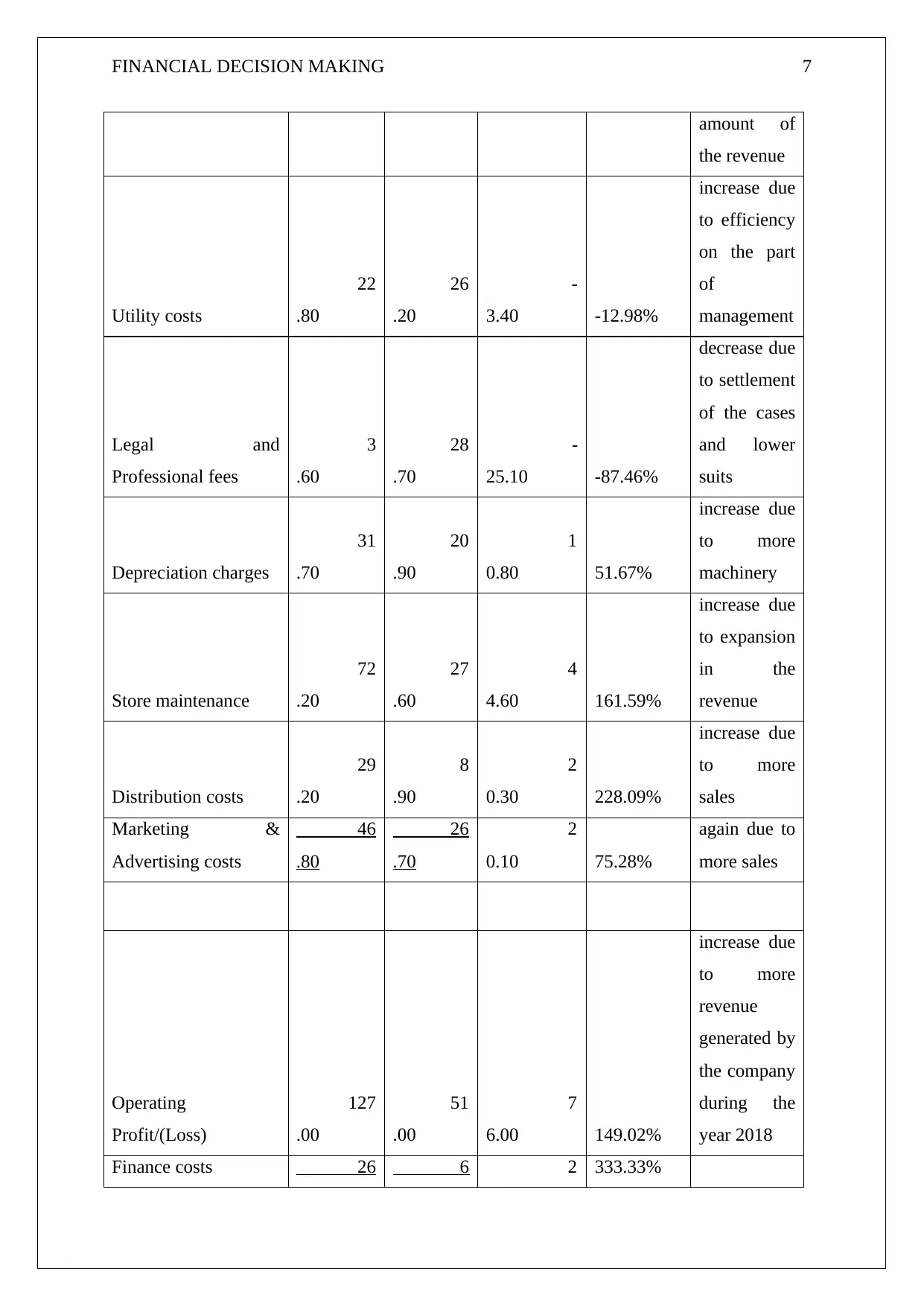
FINANCIAL DECISION MAKING 7
amount of
the revenue
Utility costs
22
.80
26
.20
-
3.40 -12.98%
increase due
to efficiency
on the part
of
management
Legal and
Professional fees
3
.60
28
.70
-
25.10 -87.46%
decrease due
to settlement
of the cases
and lower
suits
Depreciation charges
31
.70
20
.90
1
0.80 51.67%
increase due
to more
machinery
Store maintenance
72
.20
27
.60
4
4.60 161.59%
increase due
to expansion
in the
revenue
Distribution costs
29
.20
8
.90
2
0.30 228.09%
increase due
to more
sales
Marketing &
Advertising costs
46
.80
26
.70
2
0.10 75.28%
again due to
more sales
Operating
Profit/(Loss)
127
.00
51
.00
7
6.00 149.02%
increase due
to more
revenue
generated by
the company
during the
year 2018
Finance costs 26 6 2 333.33%
amount of
the revenue
Utility costs
22
.80
26
.20
-
3.40 -12.98%
increase due
to efficiency
on the part
of
management
Legal and
Professional fees
3
.60
28
.70
-
25.10 -87.46%
decrease due
to settlement
of the cases
and lower
suits
Depreciation charges
31
.70
20
.90
1
0.80 51.67%
increase due
to more
machinery
Store maintenance
72
.20
27
.60
4
4.60 161.59%
increase due
to expansion
in the
revenue
Distribution costs
29
.20
8
.90
2
0.30 228.09%
increase due
to more
sales
Marketing &
Advertising costs
46
.80
26
.70
2
0.10 75.28%
again due to
more sales
Operating
Profit/(Loss)
127
.00
51
.00
7
6.00 149.02%
increase due
to more
revenue
generated by
the company
during the
year 2018
Finance costs 26 6 2 333.33%
Paraphrase This Document
Need a fresh take? Get an instant paraphrase of this document with our AI Paraphraser
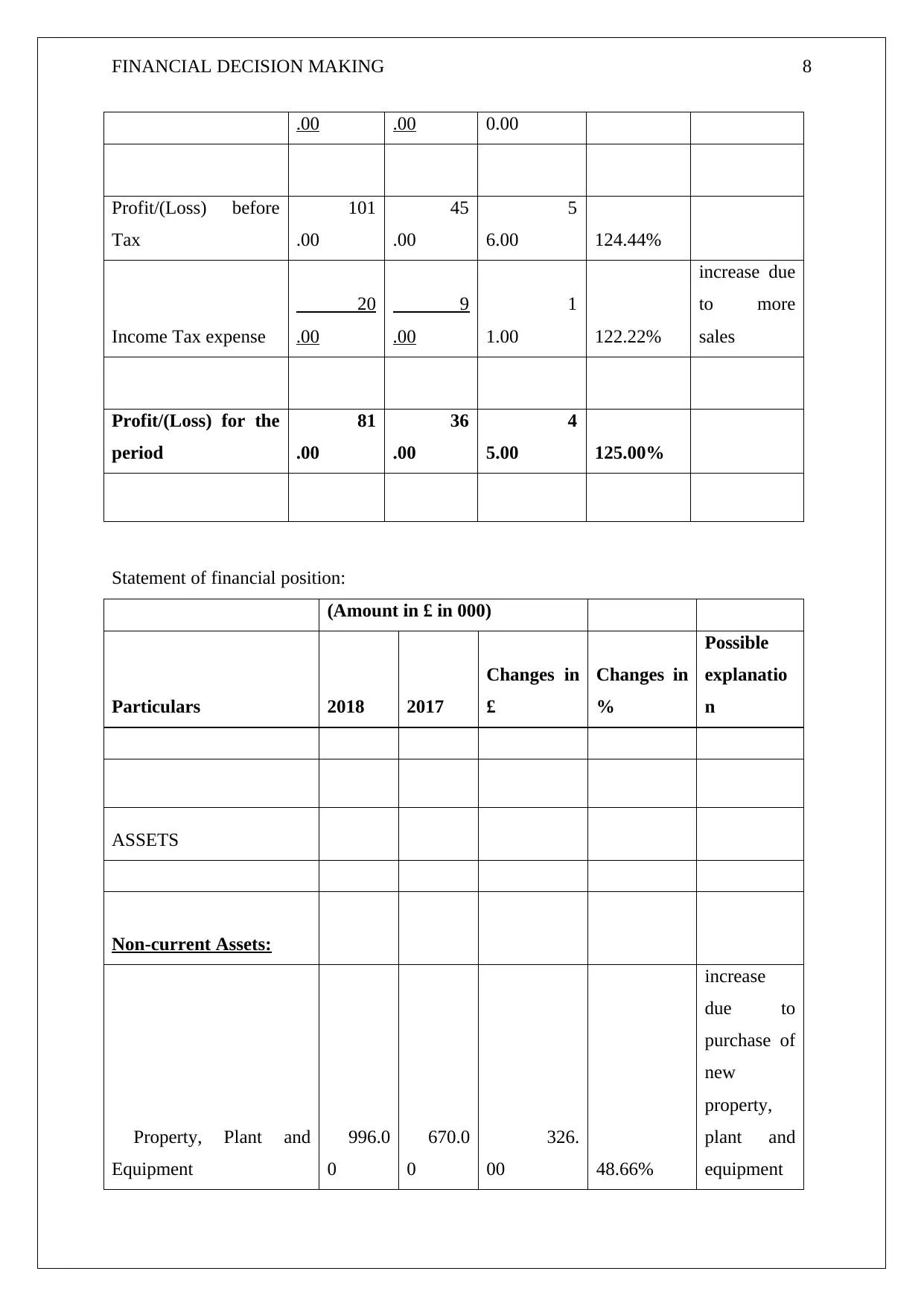
FINANCIAL DECISION MAKING 8
.00 .00 0.00
Profit/(Loss) before
Tax
101
.00
45
.00
5
6.00 124.44%
Income Tax expense
20
.00
9
.00
1
1.00 122.22%
increase due
to more
sales
Profit/(Loss) for the
period
81
.00
36
.00
4
5.00 125.00%
Statement of financial position:
(Amount in £ in 000)
Particulars 2018 2017
Changes in
£
Changes in
%
Possible
explanatio
n
ASSETS
Non-current Assets:
Property, Plant and
Equipment
996.0
0
670.0
0
326.
00 48.66%
increase
due to
purchase of
new
property,
plant and
equipment
.00 .00 0.00
Profit/(Loss) before
Tax
101
.00
45
.00
5
6.00 124.44%
Income Tax expense
20
.00
9
.00
1
1.00 122.22%
increase due
to more
sales
Profit/(Loss) for the
period
81
.00
36
.00
4
5.00 125.00%
Statement of financial position:
(Amount in £ in 000)
Particulars 2018 2017
Changes in
£
Changes in
%
Possible
explanatio
n
ASSETS
Non-current Assets:
Property, Plant and
Equipment
996.0
0
670.0
0
326.
00 48.66%
increase
due to
purchase of
new
property,
plant and
equipment
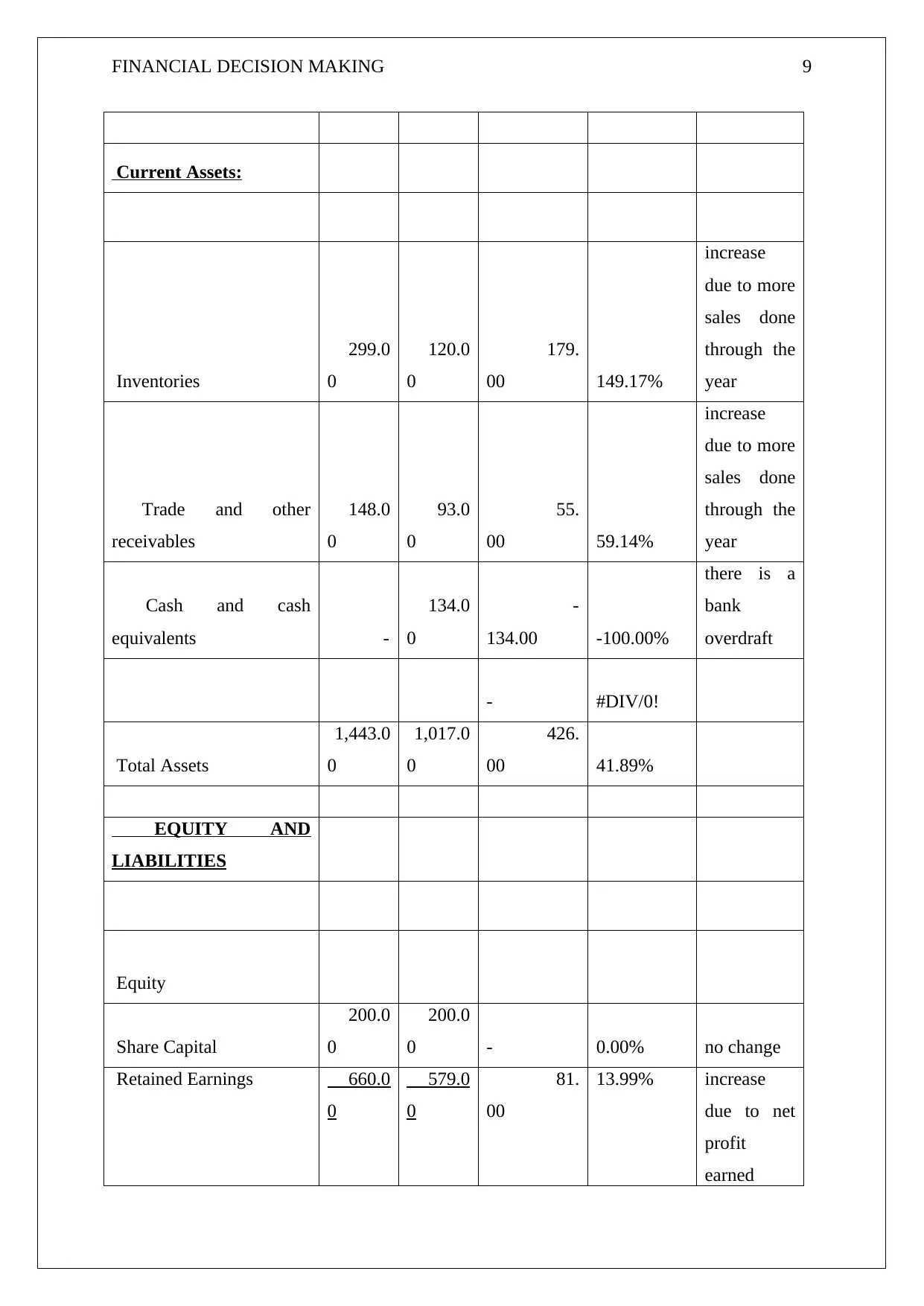
FINANCIAL DECISION MAKING 9
Current Assets:
Inventories
299.0
0
120.0
0
179.
00 149.17%
increase
due to more
sales done
through the
year
Trade and other
receivables
148.0
0
93.0
0
55.
00 59.14%
increase
due to more
sales done
through the
year
Cash and cash
equivalents -
134.0
0
-
134.00 -100.00%
there is a
bank
overdraft
- #DIV/0!
Total Assets
1,443.0
0
1,017.0
0
426.
00 41.89%
EQUITY AND
LIABILITIES
Equity
Share Capital
200.0
0
200.0
0 - 0.00% no change
Retained Earnings 660.0
0
579.0
0
81.
00
13.99% increase
due to net
profit
earned
Current Assets:
Inventories
299.0
0
120.0
0
179.
00 149.17%
increase
due to more
sales done
through the
year
Trade and other
receivables
148.0
0
93.0
0
55.
00 59.14%
increase
due to more
sales done
through the
year
Cash and cash
equivalents -
134.0
0
-
134.00 -100.00%
there is a
bank
overdraft
- #DIV/0!
Total Assets
1,443.0
0
1,017.0
0
426.
00 41.89%
EQUITY AND
LIABILITIES
Equity
Share Capital
200.0
0
200.0
0 - 0.00% no change
Retained Earnings 660.0
0
579.0
0
81.
00
13.99% increase
due to net
profit
earned
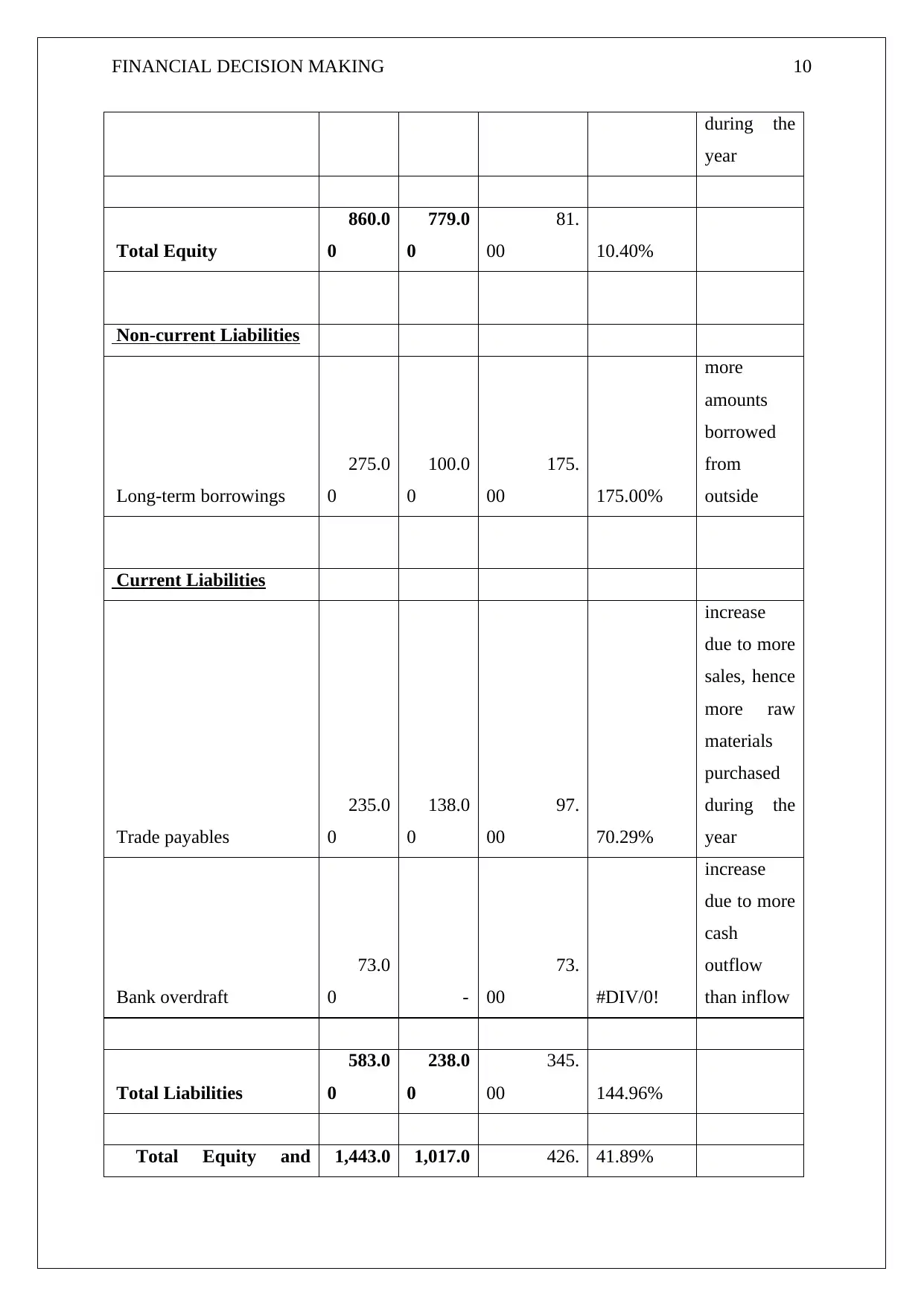
FINANCIAL DECISION MAKING 10
during the
year
Total Equity
860.0
0
779.0
0
81.
00 10.40%
Non-current Liabilities
Long-term borrowings
275.0
0
100.0
0
175.
00 175.00%
more
amounts
borrowed
from
outside
Current Liabilities
Trade payables
235.0
0
138.0
0
97.
00 70.29%
increase
due to more
sales, hence
more raw
materials
purchased
during the
year
Bank overdraft
73.0
0 -
73.
00 #DIV/0!
increase
due to more
cash
outflow
than inflow
Total Liabilities
583.0
0
238.0
0
345.
00 144.96%
Total Equity and 1,443.0 1,017.0 426. 41.89%
during the
year
Total Equity
860.0
0
779.0
0
81.
00 10.40%
Non-current Liabilities
Long-term borrowings
275.0
0
100.0
0
175.
00 175.00%
more
amounts
borrowed
from
outside
Current Liabilities
Trade payables
235.0
0
138.0
0
97.
00 70.29%
increase
due to more
sales, hence
more raw
materials
purchased
during the
year
Bank overdraft
73.0
0 -
73.
00 #DIV/0!
increase
due to more
cash
outflow
than inflow
Total Liabilities
583.0
0
238.0
0
345.
00 144.96%
Total Equity and 1,443.0 1,017.0 426. 41.89%
Secure Best Marks with AI Grader
Need help grading? Try our AI Grader for instant feedback on your assignments.
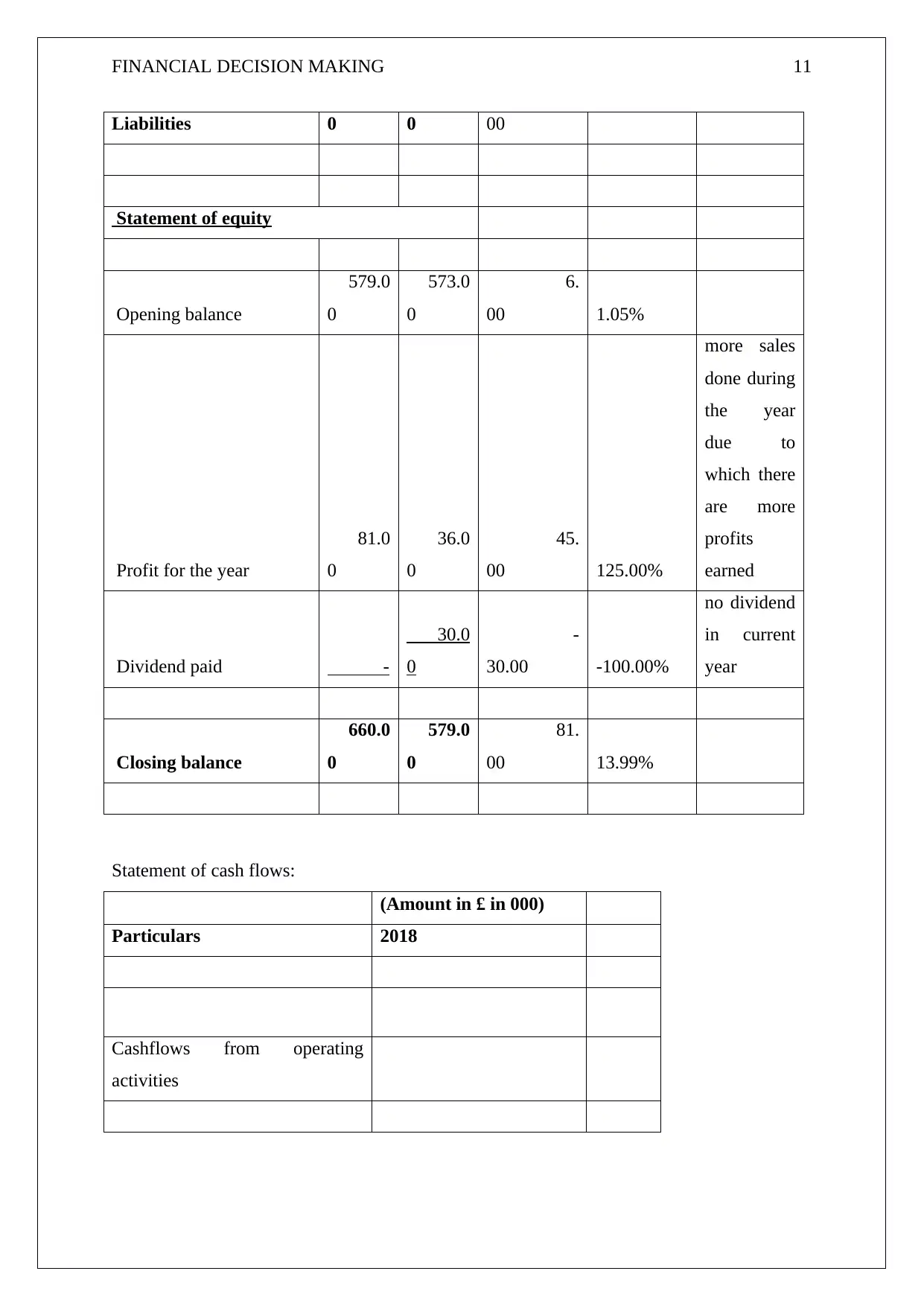
FINANCIAL DECISION MAKING 11
Liabilities 0 0 00
Statement of equity
Opening balance
579.0
0
573.0
0
6.
00 1.05%
Profit for the year
81.0
0
36.0
0
45.
00 125.00%
more sales
done during
the year
due to
which there
are more
profits
earned
Dividend paid -
30.0
0
-
30.00 -100.00%
no dividend
in current
year
Closing balance
660.0
0
579.0
0
81.
00 13.99%
Statement of cash flows:
(Amount in £ in 000)
Particulars 2018
Cashflows from operating
activities
Liabilities 0 0 00
Statement of equity
Opening balance
579.0
0
573.0
0
6.
00 1.05%
Profit for the year
81.0
0
36.0
0
45.
00 125.00%
more sales
done during
the year
due to
which there
are more
profits
earned
Dividend paid -
30.0
0
-
30.00 -100.00%
no dividend
in current
year
Closing balance
660.0
0
579.0
0
81.
00 13.99%
Statement of cash flows:
(Amount in £ in 000)
Particulars 2018
Cashflows from operating
activities
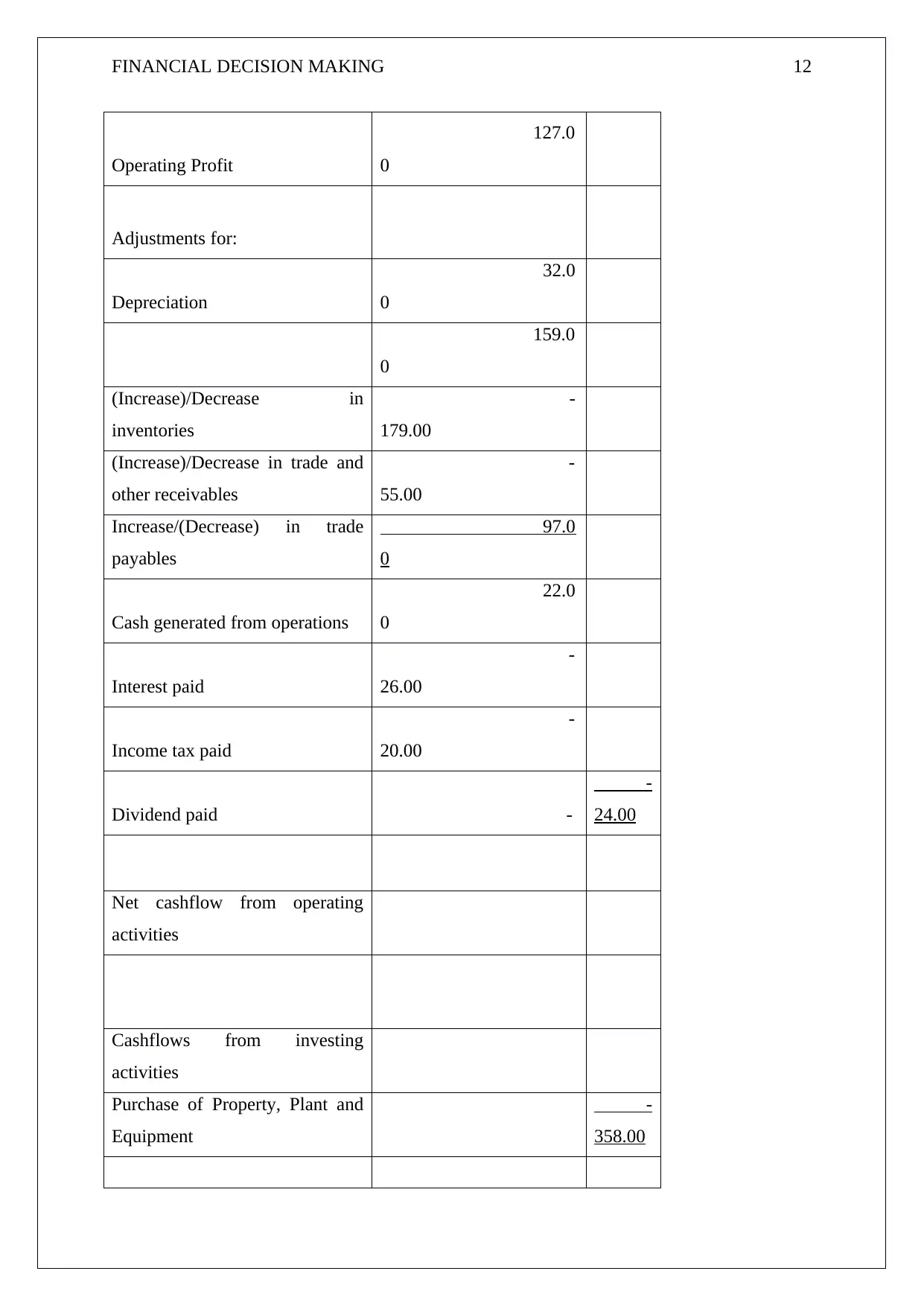
FINANCIAL DECISION MAKING 12
Operating Profit
127.0
0
Adjustments for:
Depreciation
32.0
0
159.0
0
(Increase)/Decrease in
inventories
-
179.00
(Increase)/Decrease in trade and
other receivables
-
55.00
Increase/(Decrease) in trade
payables
97.0
0
Cash generated from operations
22.0
0
Interest paid
-
26.00
Income tax paid
-
20.00
Dividend paid -
-
24.00
Net cashflow from operating
activities
Cashflows from investing
activities
Purchase of Property, Plant and
Equipment
-
358.00
Operating Profit
127.0
0
Adjustments for:
Depreciation
32.0
0
159.0
0
(Increase)/Decrease in
inventories
-
179.00
(Increase)/Decrease in trade and
other receivables
-
55.00
Increase/(Decrease) in trade
payables
97.0
0
Cash generated from operations
22.0
0
Interest paid
-
26.00
Income tax paid
-
20.00
Dividend paid -
-
24.00
Net cashflow from operating
activities
Cashflows from investing
activities
Purchase of Property, Plant and
Equipment
-
358.00
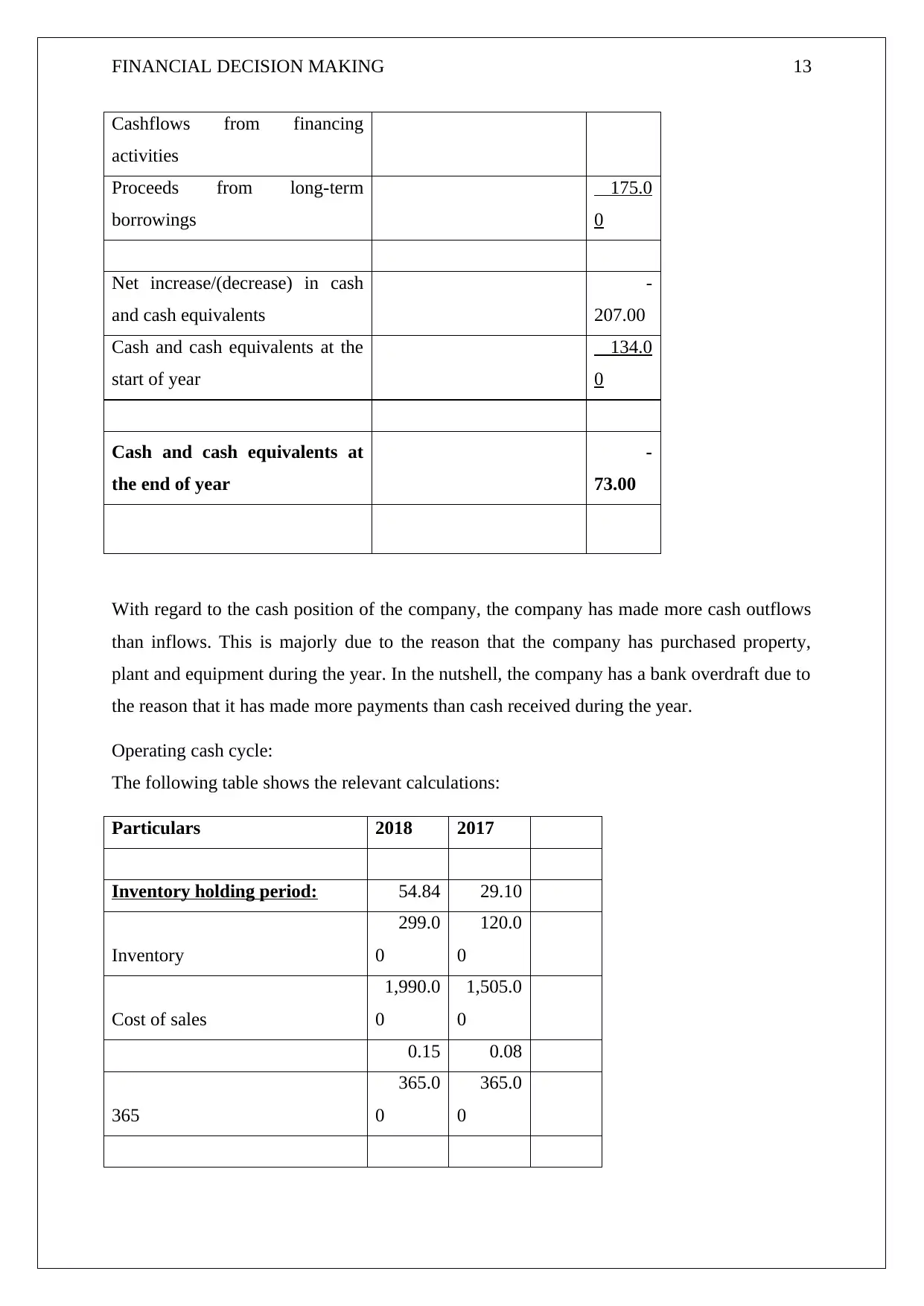
FINANCIAL DECISION MAKING 13
Cashflows from financing
activities
Proceeds from long-term
borrowings
175.0
0
Net increase/(decrease) in cash
and cash equivalents
-
207.00
Cash and cash equivalents at the
start of year
134.0
0
Cash and cash equivalents at
the end of year
-
73.00
With regard to the cash position of the company, the company has made more cash outflows
than inflows. This is majorly due to the reason that the company has purchased property,
plant and equipment during the year. In the nutshell, the company has a bank overdraft due to
the reason that it has made more payments than cash received during the year.
Operating cash cycle:
The following table shows the relevant calculations:
Particulars 2018 2017
Inventory holding period: 54.84 29.10
Inventory
299.0
0
120.0
0
Cost of sales
1,990.0
0
1,505.0
0
0.15 0.08
365
365.0
0
365.0
0
Cashflows from financing
activities
Proceeds from long-term
borrowings
175.0
0
Net increase/(decrease) in cash
and cash equivalents
-
207.00
Cash and cash equivalents at the
start of year
134.0
0
Cash and cash equivalents at
the end of year
-
73.00
With regard to the cash position of the company, the company has made more cash outflows
than inflows. This is majorly due to the reason that the company has purchased property,
plant and equipment during the year. In the nutshell, the company has a bank overdraft due to
the reason that it has made more payments than cash received during the year.
Operating cash cycle:
The following table shows the relevant calculations:
Particulars 2018 2017
Inventory holding period: 54.84 29.10
Inventory
299.0
0
120.0
0
Cost of sales
1,990.0
0
1,505.0
0
0.15 0.08
365
365.0
0
365.0
0
Paraphrase This Document
Need a fresh take? Get an instant paraphrase of this document with our AI Paraphraser
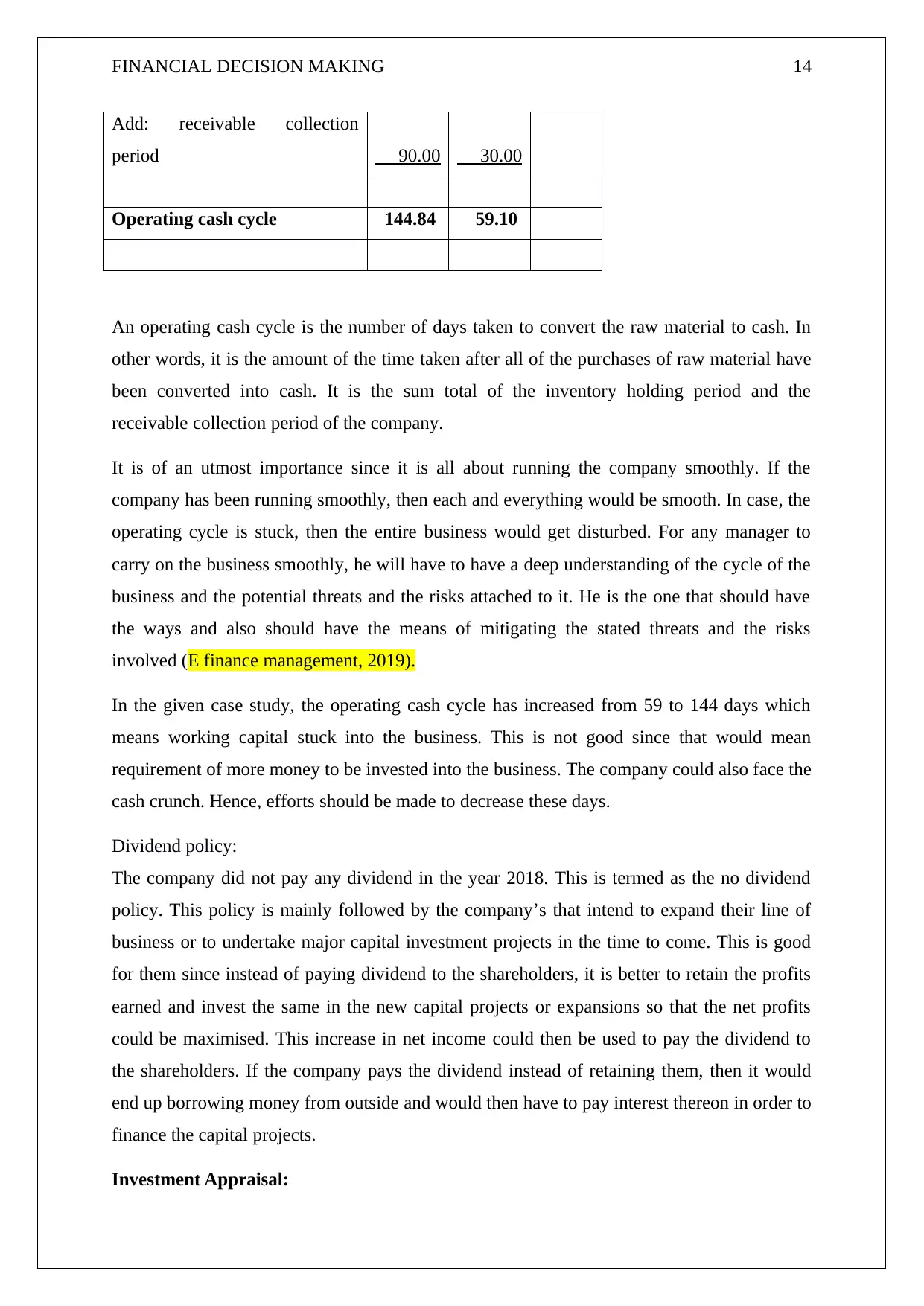
FINANCIAL DECISION MAKING 14
Add: receivable collection
period 90.00 30.00
Operating cash cycle 144.84 59.10
An operating cash cycle is the number of days taken to convert the raw material to cash. In
other words, it is the amount of the time taken after all of the purchases of raw material have
been converted into cash. It is the sum total of the inventory holding period and the
receivable collection period of the company.
It is of an utmost importance since it is all about running the company smoothly. If the
company has been running smoothly, then each and everything would be smooth. In case, the
operating cycle is stuck, then the entire business would get disturbed. For any manager to
carry on the business smoothly, he will have to have a deep understanding of the cycle of the
business and the potential threats and the risks attached to it. He is the one that should have
the ways and also should have the means of mitigating the stated threats and the risks
involved (E finance management, 2019).
In the given case study, the operating cash cycle has increased from 59 to 144 days which
means working capital stuck into the business. This is not good since that would mean
requirement of more money to be invested into the business. The company could also face the
cash crunch. Hence, efforts should be made to decrease these days.
Dividend policy:
The company did not pay any dividend in the year 2018. This is termed as the no dividend
policy. This policy is mainly followed by the company’s that intend to expand their line of
business or to undertake major capital investment projects in the time to come. This is good
for them since instead of paying dividend to the shareholders, it is better to retain the profits
earned and invest the same in the new capital projects or expansions so that the net profits
could be maximised. This increase in net income could then be used to pay the dividend to
the shareholders. If the company pays the dividend instead of retaining them, then it would
end up borrowing money from outside and would then have to pay interest thereon in order to
finance the capital projects.
Investment Appraisal:
Add: receivable collection
period 90.00 30.00
Operating cash cycle 144.84 59.10
An operating cash cycle is the number of days taken to convert the raw material to cash. In
other words, it is the amount of the time taken after all of the purchases of raw material have
been converted into cash. It is the sum total of the inventory holding period and the
receivable collection period of the company.
It is of an utmost importance since it is all about running the company smoothly. If the
company has been running smoothly, then each and everything would be smooth. In case, the
operating cycle is stuck, then the entire business would get disturbed. For any manager to
carry on the business smoothly, he will have to have a deep understanding of the cycle of the
business and the potential threats and the risks attached to it. He is the one that should have
the ways and also should have the means of mitigating the stated threats and the risks
involved (E finance management, 2019).
In the given case study, the operating cash cycle has increased from 59 to 144 days which
means working capital stuck into the business. This is not good since that would mean
requirement of more money to be invested into the business. The company could also face the
cash crunch. Hence, efforts should be made to decrease these days.
Dividend policy:
The company did not pay any dividend in the year 2018. This is termed as the no dividend
policy. This policy is mainly followed by the company’s that intend to expand their line of
business or to undertake major capital investment projects in the time to come. This is good
for them since instead of paying dividend to the shareholders, it is better to retain the profits
earned and invest the same in the new capital projects or expansions so that the net profits
could be maximised. This increase in net income could then be used to pay the dividend to
the shareholders. If the company pays the dividend instead of retaining them, then it would
end up borrowing money from outside and would then have to pay interest thereon in order to
finance the capital projects.
Investment Appraisal:
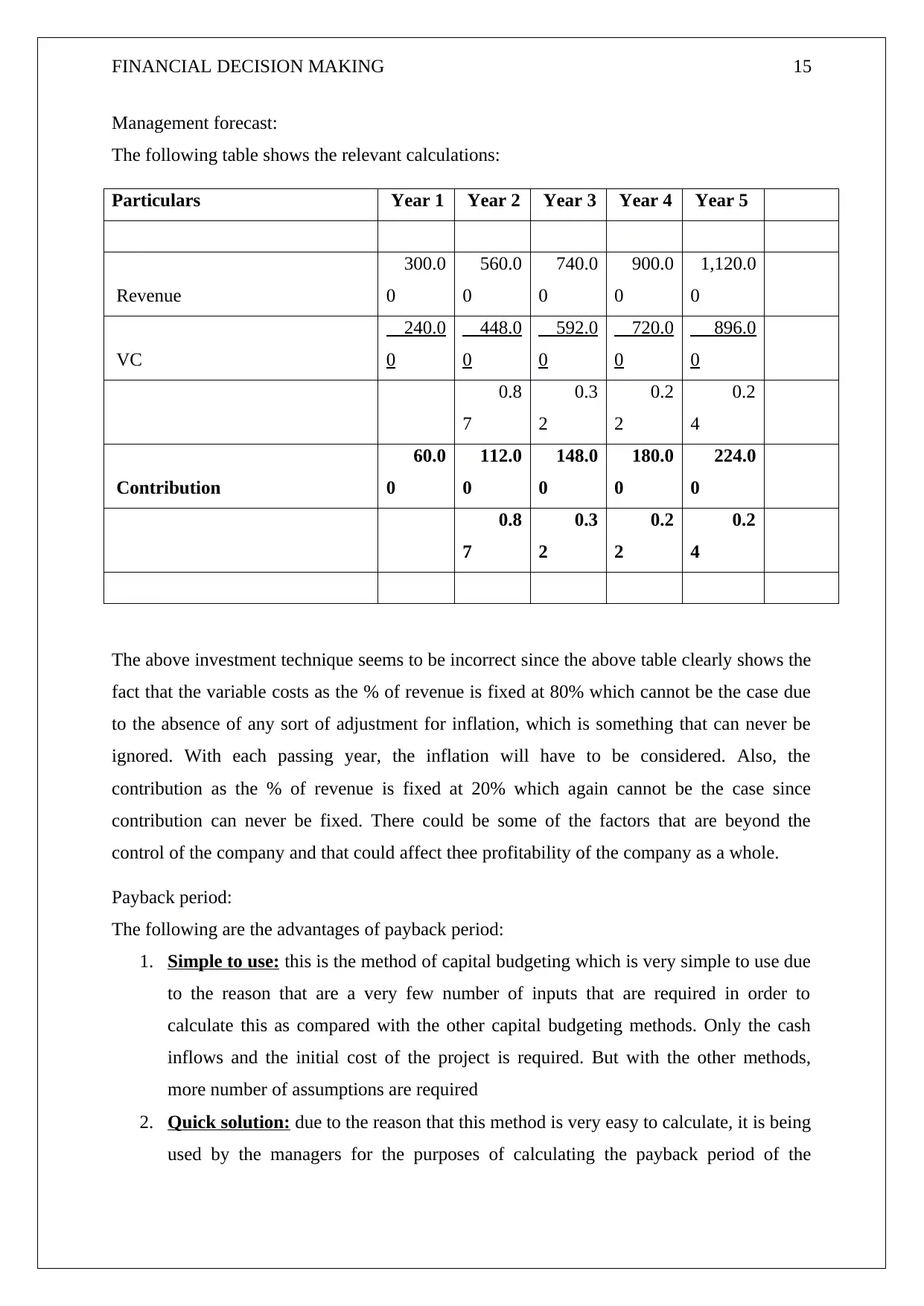
FINANCIAL DECISION MAKING 15
Management forecast:
The following table shows the relevant calculations:
Particulars Year 1 Year 2 Year 3 Year 4 Year 5
Revenue
300.0
0
560.0
0
740.0
0
900.0
0
1,120.0
0
VC
240.0
0
448.0
0
592.0
0
720.0
0
896.0
0
0.8
7
0.3
2
0.2
2
0.2
4
Contribution
60.0
0
112.0
0
148.0
0
180.0
0
224.0
0
0.8
7
0.3
2
0.2
2
0.2
4
The above investment technique seems to be incorrect since the above table clearly shows the
fact that the variable costs as the % of revenue is fixed at 80% which cannot be the case due
to the absence of any sort of adjustment for inflation, which is something that can never be
ignored. With each passing year, the inflation will have to be considered. Also, the
contribution as the % of revenue is fixed at 20% which again cannot be the case since
contribution can never be fixed. There could be some of the factors that are beyond the
control of the company and that could affect thee profitability of the company as a whole.
Payback period:
The following are the advantages of payback period:
1. Simple to use: this is the method of capital budgeting which is very simple to use due
to the reason that are a very few number of inputs that are required in order to
calculate this as compared with the other capital budgeting methods. Only the cash
inflows and the initial cost of the project is required. But with the other methods,
more number of assumptions are required
2. Quick solution: due to the reason that this method is very easy to calculate, it is being
used by the managers for the purposes of calculating the payback period of the
Management forecast:
The following table shows the relevant calculations:
Particulars Year 1 Year 2 Year 3 Year 4 Year 5
Revenue
300.0
0
560.0
0
740.0
0
900.0
0
1,120.0
0
VC
240.0
0
448.0
0
592.0
0
720.0
0
896.0
0
0.8
7
0.3
2
0.2
2
0.2
4
Contribution
60.0
0
112.0
0
148.0
0
180.0
0
224.0
0
0.8
7
0.3
2
0.2
2
0.2
4
The above investment technique seems to be incorrect since the above table clearly shows the
fact that the variable costs as the % of revenue is fixed at 80% which cannot be the case due
to the absence of any sort of adjustment for inflation, which is something that can never be
ignored. With each passing year, the inflation will have to be considered. Also, the
contribution as the % of revenue is fixed at 20% which again cannot be the case since
contribution can never be fixed. There could be some of the factors that are beyond the
control of the company and that could affect thee profitability of the company as a whole.
Payback period:
The following are the advantages of payback period:
1. Simple to use: this is the method of capital budgeting which is very simple to use due
to the reason that are a very few number of inputs that are required in order to
calculate this as compared with the other capital budgeting methods. Only the cash
inflows and the initial cost of the project is required. But with the other methods,
more number of assumptions are required
2. Quick solution: due to the reason that this method is very easy to calculate, it is being
used by the managers for the purposes of calculating the payback period of the
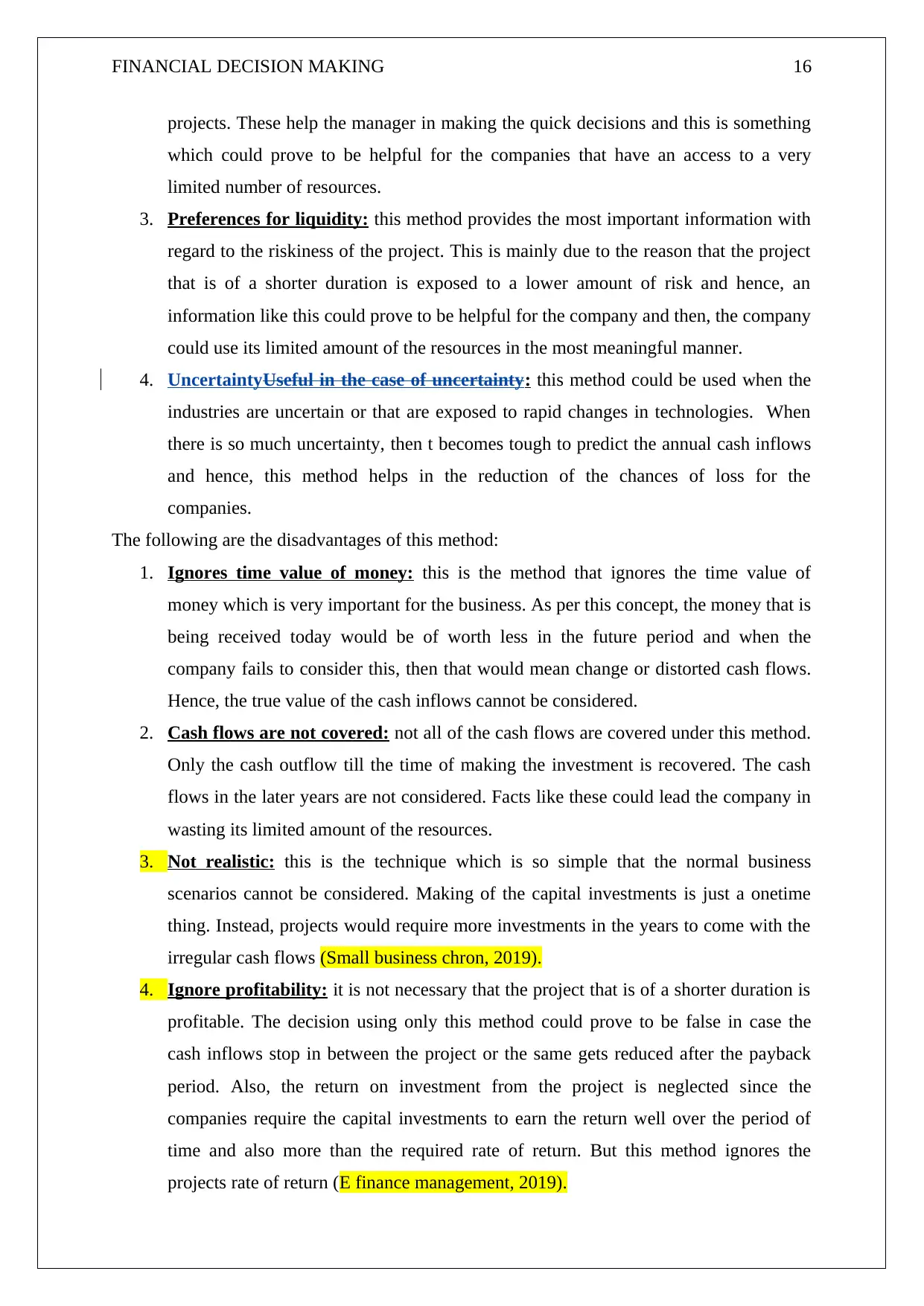
FINANCIAL DECISION MAKING 16
projects. These help the manager in making the quick decisions and this is something
which could prove to be helpful for the companies that have an access to a very
limited number of resources.
3. Preferences for liquidity: this method provides the most important information with
regard to the riskiness of the project. This is mainly due to the reason that the project
that is of a shorter duration is exposed to a lower amount of risk and hence, an
information like this could prove to be helpful for the company and then, the company
could use its limited amount of the resources in the most meaningful manner.
4. UncertaintyUseful in the case of uncertainty: this method could be used when the
industries are uncertain or that are exposed to rapid changes in technologies. When
there is so much uncertainty, then t becomes tough to predict the annual cash inflows
and hence, this method helps in the reduction of the chances of loss for the
companies.
The following are the disadvantages of this method:
1. Ignores time value of money: this is the method that ignores the time value of
money which is very important for the business. As per this concept, the money that is
being received today would be of worth less in the future period and when the
company fails to consider this, then that would mean change or distorted cash flows.
Hence, the true value of the cash inflows cannot be considered.
2. Cash flows are not covered: not all of the cash flows are covered under this method.
Only the cash outflow till the time of making the investment is recovered. The cash
flows in the later years are not considered. Facts like these could lead the company in
wasting its limited amount of the resources.
3. Not realistic: this is the technique which is so simple that the normal business
scenarios cannot be considered. Making of the capital investments is just a onetime
thing. Instead, projects would require more investments in the years to come with the
irregular cash flows (Small business chron, 2019).
4. Ignore profitability: it is not necessary that the project that is of a shorter duration is
profitable. The decision using only this method could prove to be false in case the
cash inflows stop in between the project or the same gets reduced after the payback
period. Also, the return on investment from the project is neglected since the
companies require the capital investments to earn the return well over the period of
time and also more than the required rate of return. But this method ignores the
projects rate of return (E finance management, 2019).
projects. These help the manager in making the quick decisions and this is something
which could prove to be helpful for the companies that have an access to a very
limited number of resources.
3. Preferences for liquidity: this method provides the most important information with
regard to the riskiness of the project. This is mainly due to the reason that the project
that is of a shorter duration is exposed to a lower amount of risk and hence, an
information like this could prove to be helpful for the company and then, the company
could use its limited amount of the resources in the most meaningful manner.
4. UncertaintyUseful in the case of uncertainty: this method could be used when the
industries are uncertain or that are exposed to rapid changes in technologies. When
there is so much uncertainty, then t becomes tough to predict the annual cash inflows
and hence, this method helps in the reduction of the chances of loss for the
companies.
The following are the disadvantages of this method:
1. Ignores time value of money: this is the method that ignores the time value of
money which is very important for the business. As per this concept, the money that is
being received today would be of worth less in the future period and when the
company fails to consider this, then that would mean change or distorted cash flows.
Hence, the true value of the cash inflows cannot be considered.
2. Cash flows are not covered: not all of the cash flows are covered under this method.
Only the cash outflow till the time of making the investment is recovered. The cash
flows in the later years are not considered. Facts like these could lead the company in
wasting its limited amount of the resources.
3. Not realistic: this is the technique which is so simple that the normal business
scenarios cannot be considered. Making of the capital investments is just a onetime
thing. Instead, projects would require more investments in the years to come with the
irregular cash flows (Small business chron, 2019).
4. Ignore profitability: it is not necessary that the project that is of a shorter duration is
profitable. The decision using only this method could prove to be false in case the
cash inflows stop in between the project or the same gets reduced after the payback
period. Also, the return on investment from the project is neglected since the
companies require the capital investments to earn the return well over the period of
time and also more than the required rate of return. But this method ignores the
projects rate of return (E finance management, 2019).
Secure Best Marks with AI Grader
Need help grading? Try our AI Grader for instant feedback on your assignments.
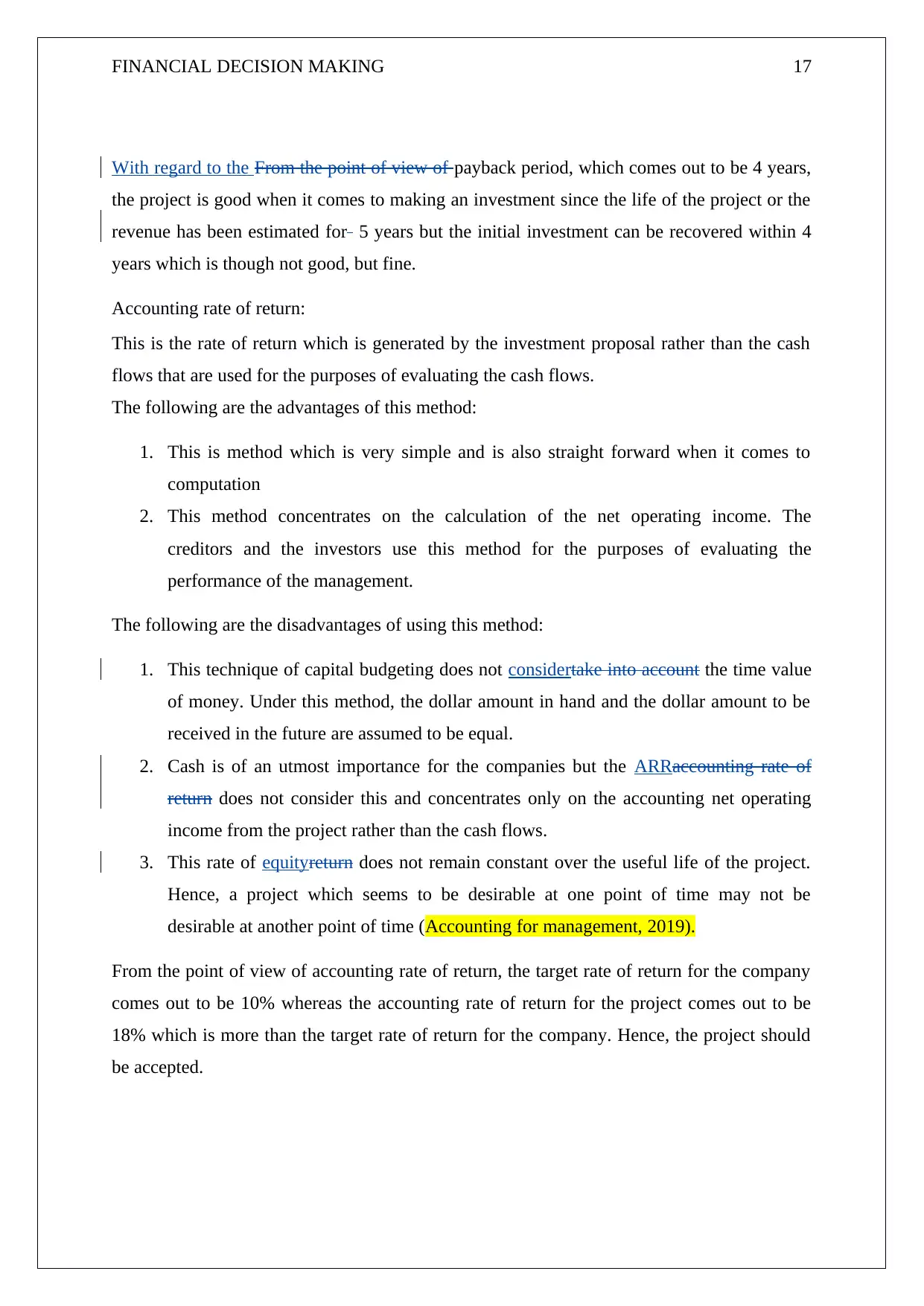
FINANCIAL DECISION MAKING 17
With regard to the From the point of view of payback period, which comes out to be 4 years,
the project is good when it comes to making an investment since the life of the project or the
revenue has been estimated for 5 years but the initial investment can be recovered within 4
years which is though not good, but fine.
Accounting rate of return:
This is the rate of return which is generated by the investment proposal rather than the cash
flows that are used for the purposes of evaluating the cash flows.
The following are the advantages of this method:
1. This is method which is very simple and is also straight forward when it comes to
computation
2. This method concentrates on the calculation of the net operating income. The
creditors and the investors use this method for the purposes of evaluating the
performance of the management.
The following are the disadvantages of using this method:
1. This technique of capital budgeting does not considertake into account the time value
of money. Under this method, the dollar amount in hand and the dollar amount to be
received in the future are assumed to be equal.
2. Cash is of an utmost importance for the companies but the ARRaccounting rate of
return does not consider this and concentrates only on the accounting net operating
income from the project rather than the cash flows.
3. This rate of equityreturn does not remain constant over the useful life of the project.
Hence, a project which seems to be desirable at one point of time may not be
desirable at another point of time (Accounting for management, 2019).
From the point of view of accounting rate of return, the target rate of return for the company
comes out to be 10% whereas the accounting rate of return for the project comes out to be
18% which is more than the target rate of return for the company. Hence, the project should
be accepted.
With regard to the From the point of view of payback period, which comes out to be 4 years,
the project is good when it comes to making an investment since the life of the project or the
revenue has been estimated for 5 years but the initial investment can be recovered within 4
years which is though not good, but fine.
Accounting rate of return:
This is the rate of return which is generated by the investment proposal rather than the cash
flows that are used for the purposes of evaluating the cash flows.
The following are the advantages of this method:
1. This is method which is very simple and is also straight forward when it comes to
computation
2. This method concentrates on the calculation of the net operating income. The
creditors and the investors use this method for the purposes of evaluating the
performance of the management.
The following are the disadvantages of using this method:
1. This technique of capital budgeting does not considertake into account the time value
of money. Under this method, the dollar amount in hand and the dollar amount to be
received in the future are assumed to be equal.
2. Cash is of an utmost importance for the companies but the ARRaccounting rate of
return does not consider this and concentrates only on the accounting net operating
income from the project rather than the cash flows.
3. This rate of equityreturn does not remain constant over the useful life of the project.
Hence, a project which seems to be desirable at one point of time may not be
desirable at another point of time (Accounting for management, 2019).
From the point of view of accounting rate of return, the target rate of return for the company
comes out to be 10% whereas the accounting rate of return for the project comes out to be
18% which is more than the target rate of return for the company. Hence, the project should
be accepted.
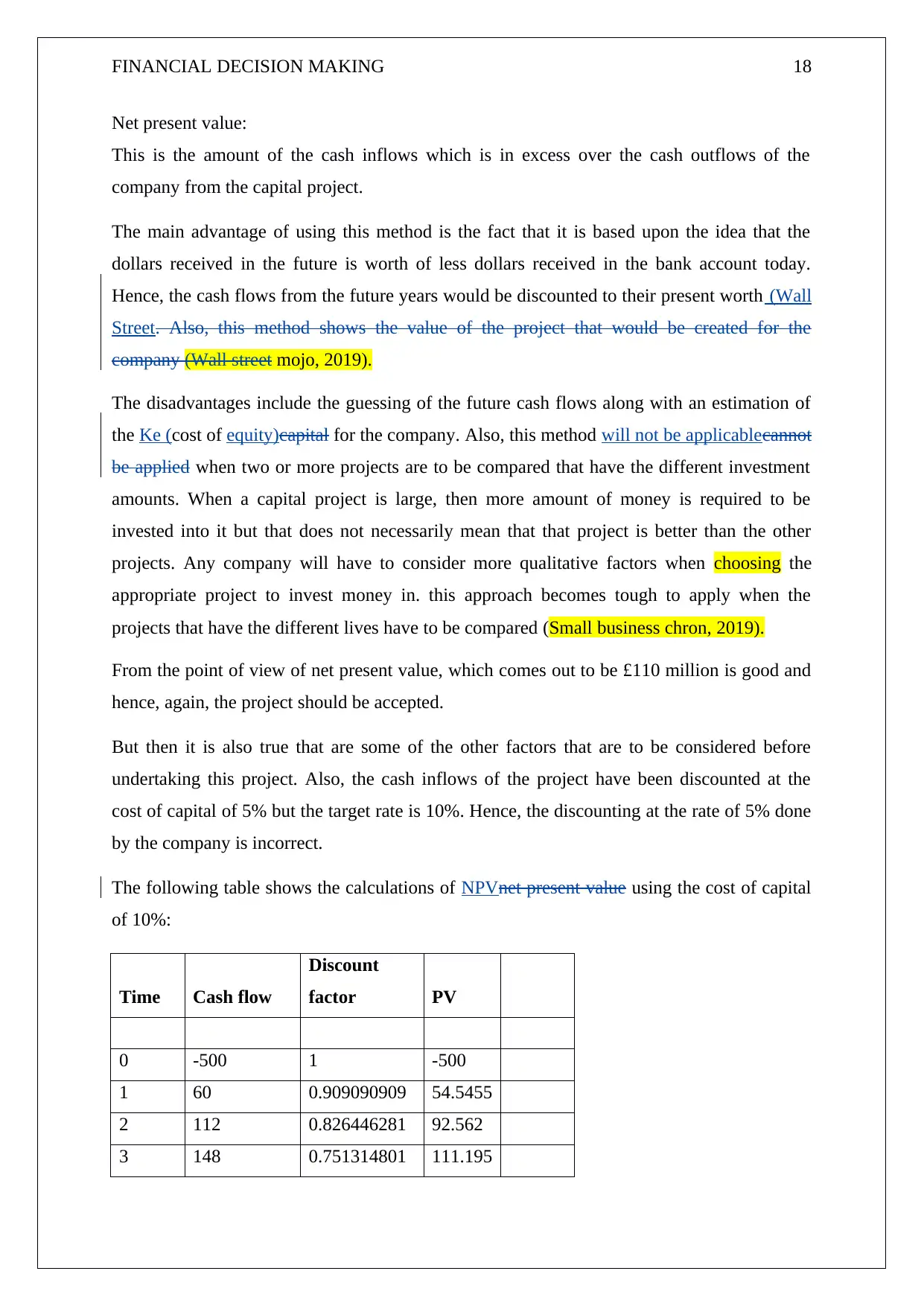
FINANCIAL DECISION MAKING 18
Net present value:
This is the amount of the cash inflows which is in excess over the cash outflows of the
company from the capital project.
The main advantage of using this method is the fact that it is based upon the idea that the
dollars received in the future is worth of less dollars received in the bank account today.
Hence, the cash flows from the future years would be discounted to their present worth (Wall
Street. Also, this method shows the value of the project that would be created for the
company (Wall street mojo, 2019).
The disadvantages include the guessing of the future cash flows along with an estimation of
the Ke (cost of equity)capital for the company. Also, this method will not be applicablecannot
be applied when two or more projects are to be compared that have the different investment
amounts. When a capital project is large, then more amount of money is required to be
invested into it but that does not necessarily mean that that project is better than the other
projects. Any company will have to consider more qualitative factors when choosing the
appropriate project to invest money in. this approach becomes tough to apply when the
projects that have the different lives have to be compared (Small business chron, 2019).
From the point of view of net present value, which comes out to be £110 million is good and
hence, again, the project should be accepted.
But then it is also true that are some of the other factors that are to be considered before
undertaking this project. Also, the cash inflows of the project have been discounted at the
cost of capital of 5% but the target rate is 10%. Hence, the discounting at the rate of 5% done
by the company is incorrect.
The following table shows the calculations of NPVnet present value using the cost of capital
of 10%:
Time Cash flow
Discount
factor PV
0 -500 1 -500
1 60 0.909090909 54.5455
2 112 0.826446281 92.562
3 148 0.751314801 111.195
Net present value:
This is the amount of the cash inflows which is in excess over the cash outflows of the
company from the capital project.
The main advantage of using this method is the fact that it is based upon the idea that the
dollars received in the future is worth of less dollars received in the bank account today.
Hence, the cash flows from the future years would be discounted to their present worth (Wall
Street. Also, this method shows the value of the project that would be created for the
company (Wall street mojo, 2019).
The disadvantages include the guessing of the future cash flows along with an estimation of
the Ke (cost of equity)capital for the company. Also, this method will not be applicablecannot
be applied when two or more projects are to be compared that have the different investment
amounts. When a capital project is large, then more amount of money is required to be
invested into it but that does not necessarily mean that that project is better than the other
projects. Any company will have to consider more qualitative factors when choosing the
appropriate project to invest money in. this approach becomes tough to apply when the
projects that have the different lives have to be compared (Small business chron, 2019).
From the point of view of net present value, which comes out to be £110 million is good and
hence, again, the project should be accepted.
But then it is also true that are some of the other factors that are to be considered before
undertaking this project. Also, the cash inflows of the project have been discounted at the
cost of capital of 5% but the target rate is 10%. Hence, the discounting at the rate of 5% done
by the company is incorrect.
The following table shows the calculations of NPVnet present value using the cost of capital
of 10%:
Time Cash flow
Discount
factor PV
0 -500 1 -500
1 60 0.909090909 54.5455
2 112 0.826446281 92.562
3 148 0.751314801 111.195
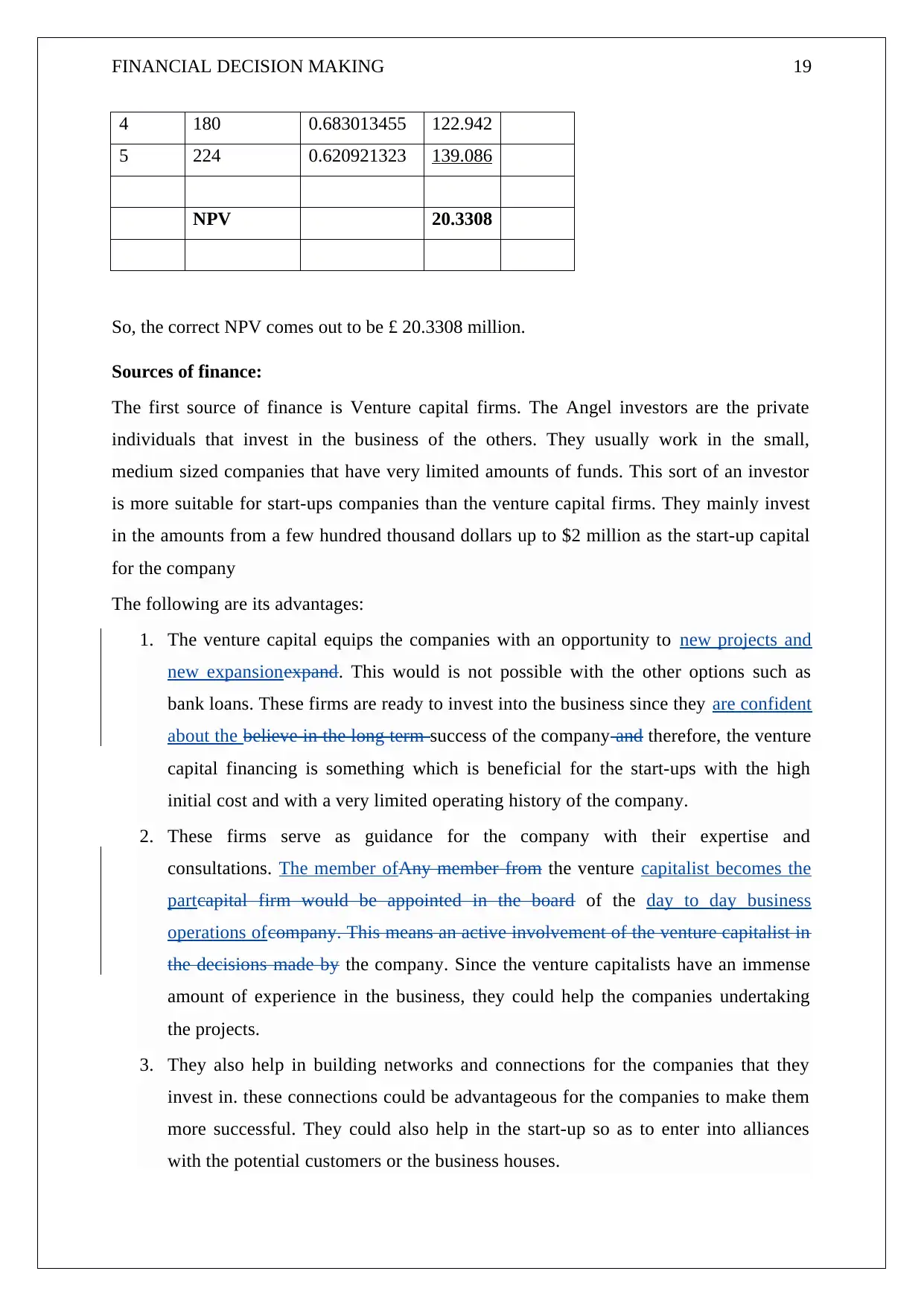
FINANCIAL DECISION MAKING 19
4 180 0.683013455 122.942
5 224 0.620921323 139.086
NPV 20.3308
So, the correct NPV comes out to be £ 20.3308 million.
Sources of finance:
The first source of finance is Venture capital firms. The Angel investors are the private
individuals that invest in the business of the others. They usually work in the small,
medium sized companies that have very limited amounts of funds. This sort of an investor
is more suitable for start-ups companies than the venture capital firms. They mainly invest
in the amounts from a few hundred thousand dollars up to $2 million as the start-up capital
for the company
The following are its advantages:
1. The venture capital equips the companies with an opportunity to new projects and
new expansionexpand. This would is not possible with the other options such as
bank loans. These firms are ready to invest into the business since they are confident
about the believe in the long term success of the company and therefore, the venture
capital financing is something which is beneficial for the start-ups with the high
initial cost and with a very limited operating history of the company.
2. These firms serve as guidance for the company with their expertise and
consultations. The member ofAny member from the venture capitalist becomes the
partcapital firm would be appointed in the board of the day to day business
operations ofcompany. This means an active involvement of the venture capitalist in
the decisions made by the company. Since the venture capitalists have an immense
amount of experience in the business, they could help the companies undertaking
the projects.
3. They also help in building networks and connections for the companies that they
invest in. these connections could be advantageous for the companies to make them
more successful. They could also help in the start-up so as to enter into alliances
with the potential customers or the business houses.
4 180 0.683013455 122.942
5 224 0.620921323 139.086
NPV 20.3308
So, the correct NPV comes out to be £ 20.3308 million.
Sources of finance:
The first source of finance is Venture capital firms. The Angel investors are the private
individuals that invest in the business of the others. They usually work in the small,
medium sized companies that have very limited amounts of funds. This sort of an investor
is more suitable for start-ups companies than the venture capital firms. They mainly invest
in the amounts from a few hundred thousand dollars up to $2 million as the start-up capital
for the company
The following are its advantages:
1. The venture capital equips the companies with an opportunity to new projects and
new expansionexpand. This would is not possible with the other options such as
bank loans. These firms are ready to invest into the business since they are confident
about the believe in the long term success of the company and therefore, the venture
capital financing is something which is beneficial for the start-ups with the high
initial cost and with a very limited operating history of the company.
2. These firms serve as guidance for the company with their expertise and
consultations. The member ofAny member from the venture capitalist becomes the
partcapital firm would be appointed in the board of the day to day business
operations ofcompany. This means an active involvement of the venture capitalist in
the decisions made by the company. Since the venture capitalists have an immense
amount of experience in the business, they could help the companies undertaking
the projects.
3. They also help in building networks and connections for the companies that they
invest in. these connections could be advantageous for the companies to make them
more successful. They could also help in the start-up so as to enter into alliances
with the potential customers or the business houses.
Paraphrase This Document
Need a fresh take? Get an instant paraphrase of this document with our AI Paraphraser
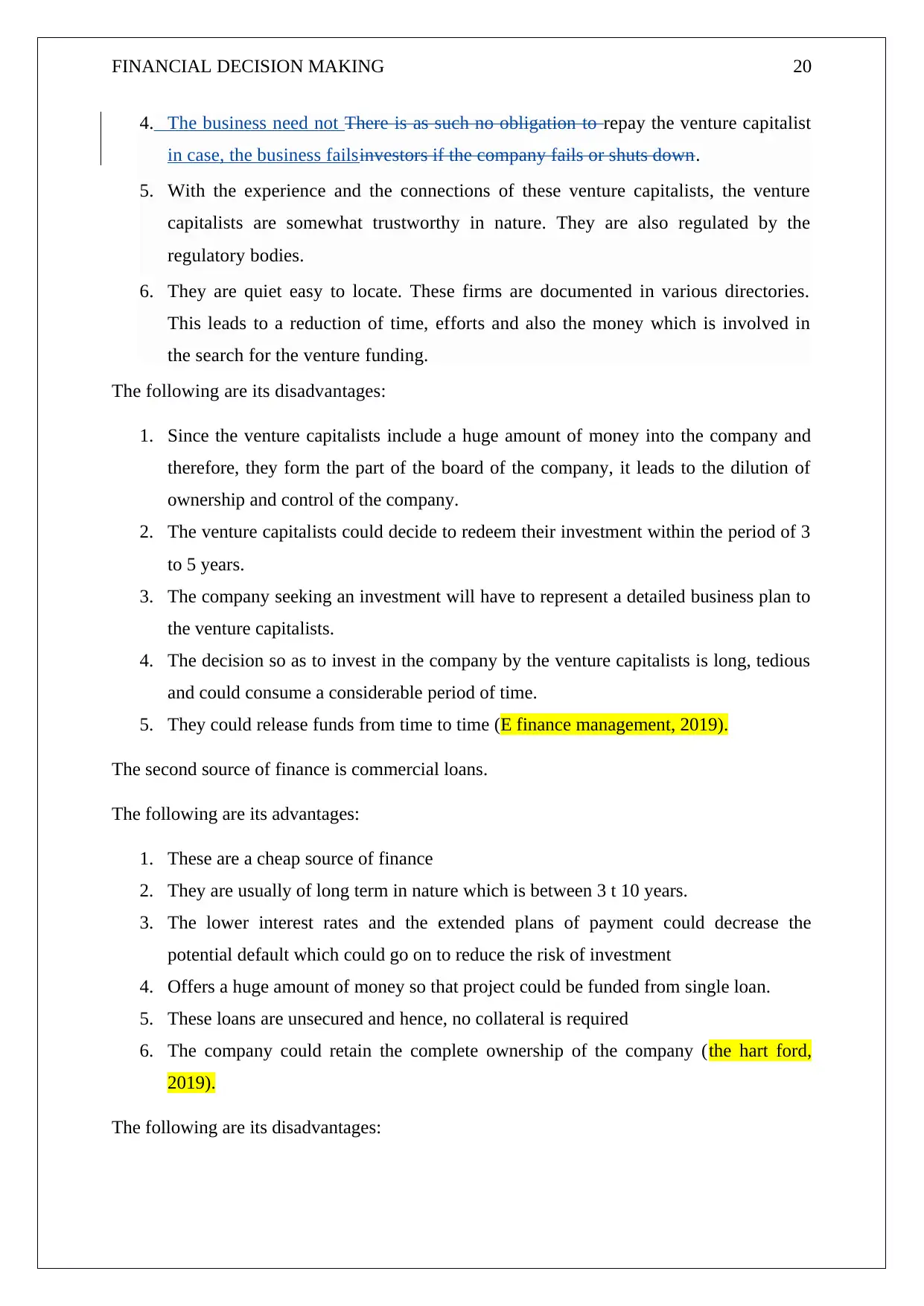
FINANCIAL DECISION MAKING 20
4. The business need not There is as such no obligation to repay the venture capitalist
in case, the business failsinvestors if the company fails or shuts down.
5. With the experience and the connections of these venture capitalists, the venture
capitalists are somewhat trustworthy in nature. They are also regulated by the
regulatory bodies.
6. They are quiet easy to locate. These firms are documented in various directories.
This leads to a reduction of time, efforts and also the money which is involved in
the search for the venture funding.
The following are its disadvantages:
1. Since the venture capitalists include a huge amount of money into the company and
therefore, they form the part of the board of the company, it leads to the dilution of
ownership and control of the company.
2. The venture capitalists could decide to redeem their investment within the period of 3
to 5 years.
3. The company seeking an investment will have to represent a detailed business plan to
the venture capitalists.
4. The decision so as to invest in the company by the venture capitalists is long, tedious
and could consume a considerable period of time.
5. They could release funds from time to time (E finance management, 2019).
The second source of finance is commercial loans.
The following are its advantages:
1. These are a cheap source of finance
2. They are usually of long term in nature which is between 3 t 10 years.
3. The lower interest rates and the extended plans of payment could decrease the
potential default which could go on to reduce the risk of investment
4. Offers a huge amount of money so that project could be funded from single loan.
5. These loans are unsecured and hence, no collateral is required
6. The company could retain the complete ownership of the company (the hart ford,
2019).
The following are its disadvantages:
4. The business need not There is as such no obligation to repay the venture capitalist
in case, the business failsinvestors if the company fails or shuts down.
5. With the experience and the connections of these venture capitalists, the venture
capitalists are somewhat trustworthy in nature. They are also regulated by the
regulatory bodies.
6. They are quiet easy to locate. These firms are documented in various directories.
This leads to a reduction of time, efforts and also the money which is involved in
the search for the venture funding.
The following are its disadvantages:
1. Since the venture capitalists include a huge amount of money into the company and
therefore, they form the part of the board of the company, it leads to the dilution of
ownership and control of the company.
2. The venture capitalists could decide to redeem their investment within the period of 3
to 5 years.
3. The company seeking an investment will have to represent a detailed business plan to
the venture capitalists.
4. The decision so as to invest in the company by the venture capitalists is long, tedious
and could consume a considerable period of time.
5. They could release funds from time to time (E finance management, 2019).
The second source of finance is commercial loans.
The following are its advantages:
1. These are a cheap source of finance
2. They are usually of long term in nature which is between 3 t 10 years.
3. The lower interest rates and the extended plans of payment could decrease the
potential default which could go on to reduce the risk of investment
4. Offers a huge amount of money so that project could be funded from single loan.
5. These loans are unsecured and hence, no collateral is required
6. The company could retain the complete ownership of the company (the hart ford,
2019).
The following are its disadvantages:
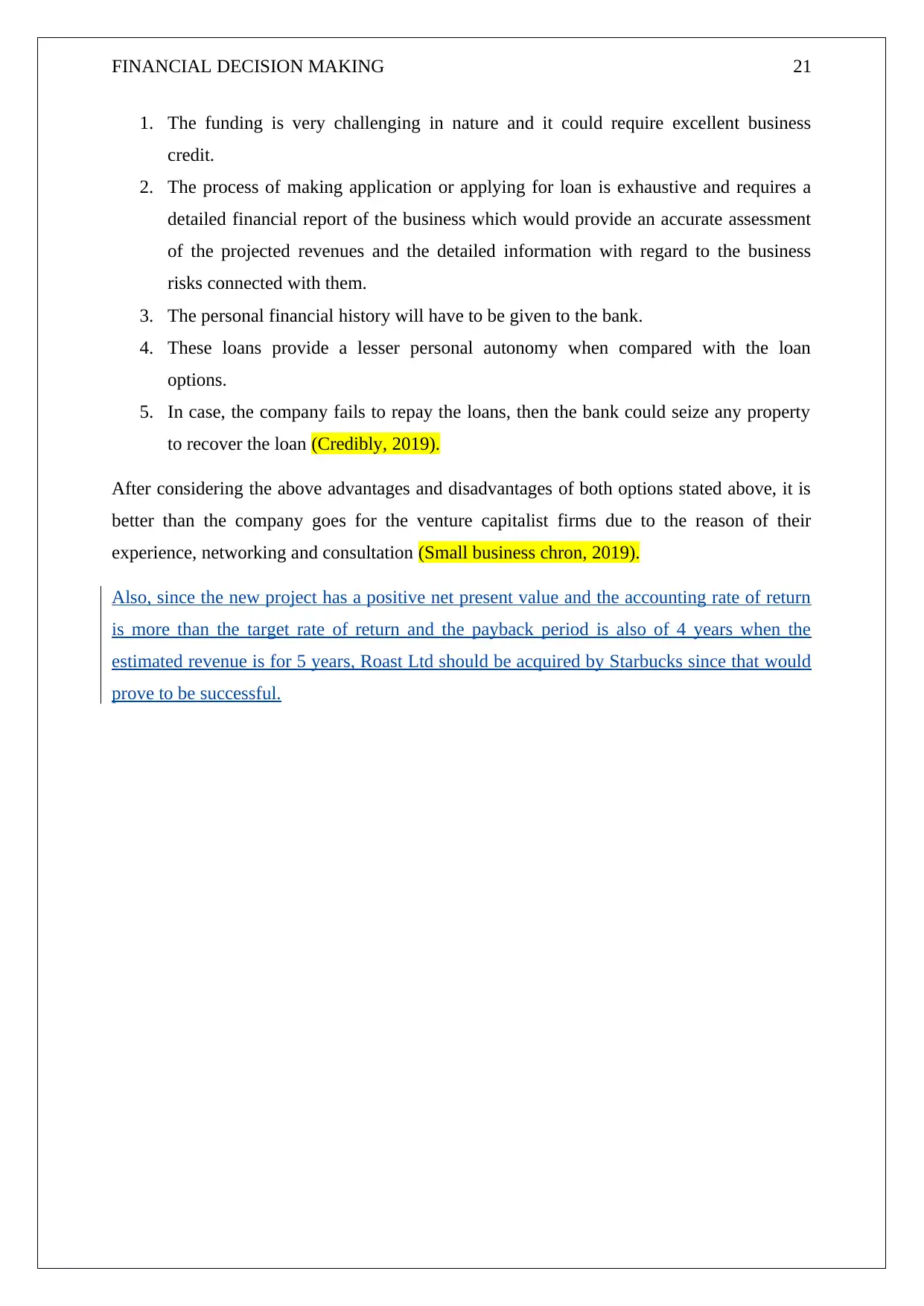
FINANCIAL DECISION MAKING 21
1. The funding is very challenging in nature and it could require excellent business
credit.
2. The process of making application or applying for loan is exhaustive and requires a
detailed financial report of the business which would provide an accurate assessment
of the projected revenues and the detailed information with regard to the business
risks connected with them.
3. The personal financial history will have to be given to the bank.
4. These loans provide a lesser personal autonomy when compared with the loan
options.
5. In case, the company fails to repay the loans, then the bank could seize any property
to recover the loan (Credibly, 2019).
After considering the above advantages and disadvantages of both options stated above, it is
better than the company goes for the venture capitalist firms due to the reason of their
experience, networking and consultation (Small business chron, 2019).
Also, since the new project has a positive net present value and the accounting rate of return
is more than the target rate of return and the payback period is also of 4 years when the
estimated revenue is for 5 years, Roast Ltd should be acquired by Starbucks since that would
prove to be successful.
1. The funding is very challenging in nature and it could require excellent business
credit.
2. The process of making application or applying for loan is exhaustive and requires a
detailed financial report of the business which would provide an accurate assessment
of the projected revenues and the detailed information with regard to the business
risks connected with them.
3. The personal financial history will have to be given to the bank.
4. These loans provide a lesser personal autonomy when compared with the loan
options.
5. In case, the company fails to repay the loans, then the bank could seize any property
to recover the loan (Credibly, 2019).
After considering the above advantages and disadvantages of both options stated above, it is
better than the company goes for the venture capitalist firms due to the reason of their
experience, networking and consultation (Small business chron, 2019).
Also, since the new project has a positive net present value and the accounting rate of return
is more than the target rate of return and the payback period is also of 4 years when the
estimated revenue is for 5 years, Roast Ltd should be acquired by Starbucks since that would
prove to be successful.
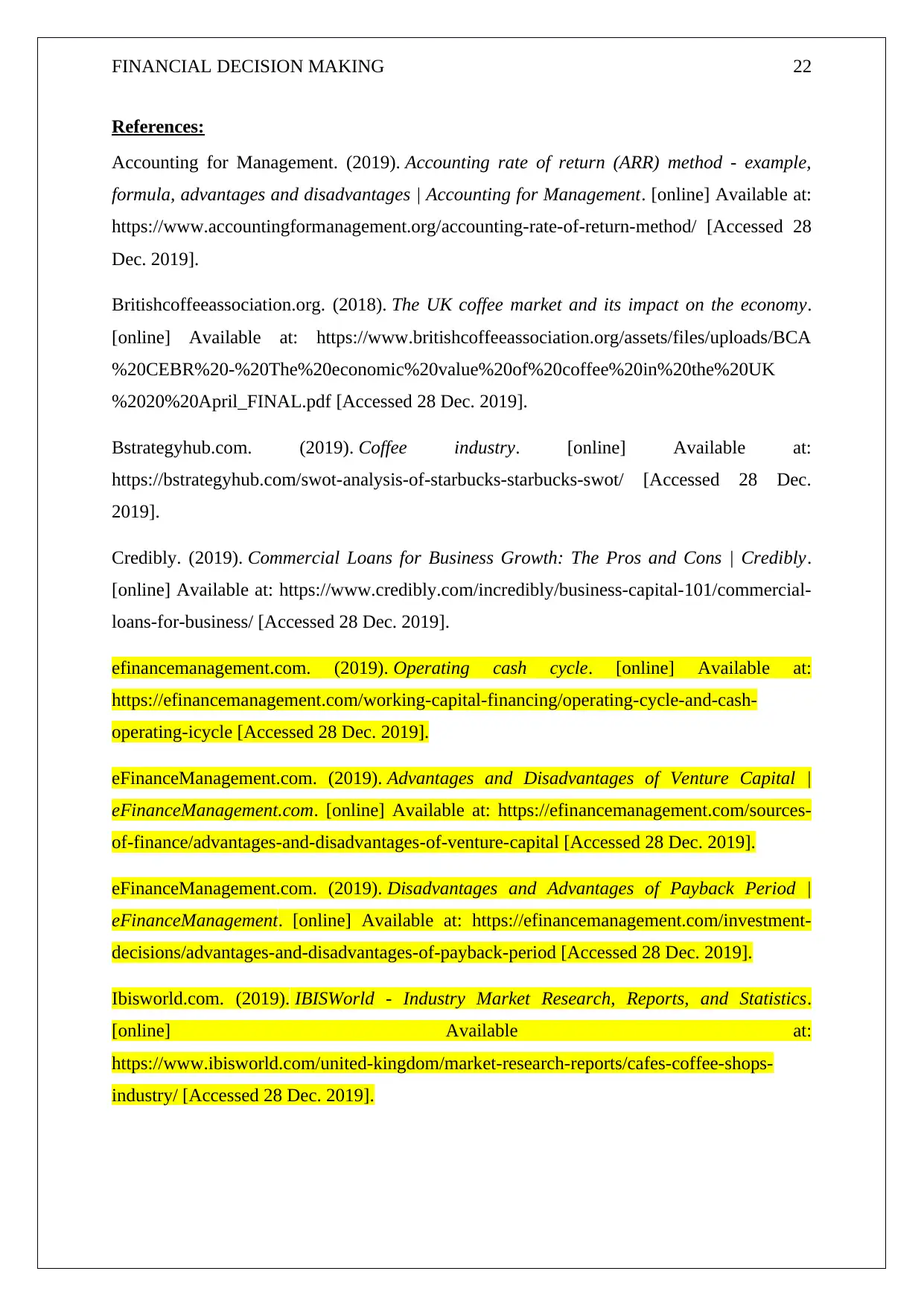
FINANCIAL DECISION MAKING 22
References:
Accounting for Management. (2019). Accounting rate of return (ARR) method - example,
formula, advantages and disadvantages | Accounting for Management. [online] Available at:
https://www.accountingformanagement.org/accounting-rate-of-return-method/ [Accessed 28
Dec. 2019].
Britishcoffeeassociation.org. (2018). The UK coffee market and its impact on the economy.
[online] Available at: https://www.britishcoffeeassociation.org/assets/files/uploads/BCA
%20CEBR%20-%20The%20economic%20value%20of%20coffee%20in%20the%20UK
%2020%20April_FINAL.pdf [Accessed 28 Dec. 2019].
Bstrategyhub.com. (2019). Coffee industry. [online] Available at:
https://bstrategyhub.com/swot-analysis-of-starbucks-starbucks-swot/ [Accessed 28 Dec.
2019].
Credibly. (2019). Commercial Loans for Business Growth: The Pros and Cons | Credibly.
[online] Available at: https://www.credibly.com/incredibly/business-capital-101/commercial-
loans-for-business/ [Accessed 28 Dec. 2019].
efinancemanagement.com. (2019). Operating cash cycle. [online] Available at:
https://efinancemanagement.com/working-capital-financing/operating-cycle-and-cash-
operating-icycle [Accessed 28 Dec. 2019].
eFinanceManagement.com. (2019). Advantages and Disadvantages of Venture Capital |
eFinanceManagement.com. [online] Available at: https://efinancemanagement.com/sources-
of-finance/advantages-and-disadvantages-of-venture-capital [Accessed 28 Dec. 2019].
eFinanceManagement.com. (2019). Disadvantages and Advantages of Payback Period |
eFinanceManagement. [online] Available at: https://efinancemanagement.com/investment-
decisions/advantages-and-disadvantages-of-payback-period [Accessed 28 Dec. 2019].
Ibisworld.com. (2019). IBISWorld - Industry Market Research, Reports, and Statistics.
[online] Available at:
https://www.ibisworld.com/united-kingdom/market-research-reports/cafes-coffee-shops-
industry/ [Accessed 28 Dec. 2019].
References:
Accounting for Management. (2019). Accounting rate of return (ARR) method - example,
formula, advantages and disadvantages | Accounting for Management. [online] Available at:
https://www.accountingformanagement.org/accounting-rate-of-return-method/ [Accessed 28
Dec. 2019].
Britishcoffeeassociation.org. (2018). The UK coffee market and its impact on the economy.
[online] Available at: https://www.britishcoffeeassociation.org/assets/files/uploads/BCA
%20CEBR%20-%20The%20economic%20value%20of%20coffee%20in%20the%20UK
%2020%20April_FINAL.pdf [Accessed 28 Dec. 2019].
Bstrategyhub.com. (2019). Coffee industry. [online] Available at:
https://bstrategyhub.com/swot-analysis-of-starbucks-starbucks-swot/ [Accessed 28 Dec.
2019].
Credibly. (2019). Commercial Loans for Business Growth: The Pros and Cons | Credibly.
[online] Available at: https://www.credibly.com/incredibly/business-capital-101/commercial-
loans-for-business/ [Accessed 28 Dec. 2019].
efinancemanagement.com. (2019). Operating cash cycle. [online] Available at:
https://efinancemanagement.com/working-capital-financing/operating-cycle-and-cash-
operating-icycle [Accessed 28 Dec. 2019].
eFinanceManagement.com. (2019). Advantages and Disadvantages of Venture Capital |
eFinanceManagement.com. [online] Available at: https://efinancemanagement.com/sources-
of-finance/advantages-and-disadvantages-of-venture-capital [Accessed 28 Dec. 2019].
eFinanceManagement.com. (2019). Disadvantages and Advantages of Payback Period |
eFinanceManagement. [online] Available at: https://efinancemanagement.com/investment-
decisions/advantages-and-disadvantages-of-payback-period [Accessed 28 Dec. 2019].
Ibisworld.com. (2019). IBISWorld - Industry Market Research, Reports, and Statistics.
[online] Available at:
https://www.ibisworld.com/united-kingdom/market-research-reports/cafes-coffee-shops-
industry/ [Accessed 28 Dec. 2019].
Secure Best Marks with AI Grader
Need help grading? Try our AI Grader for instant feedback on your assignments.
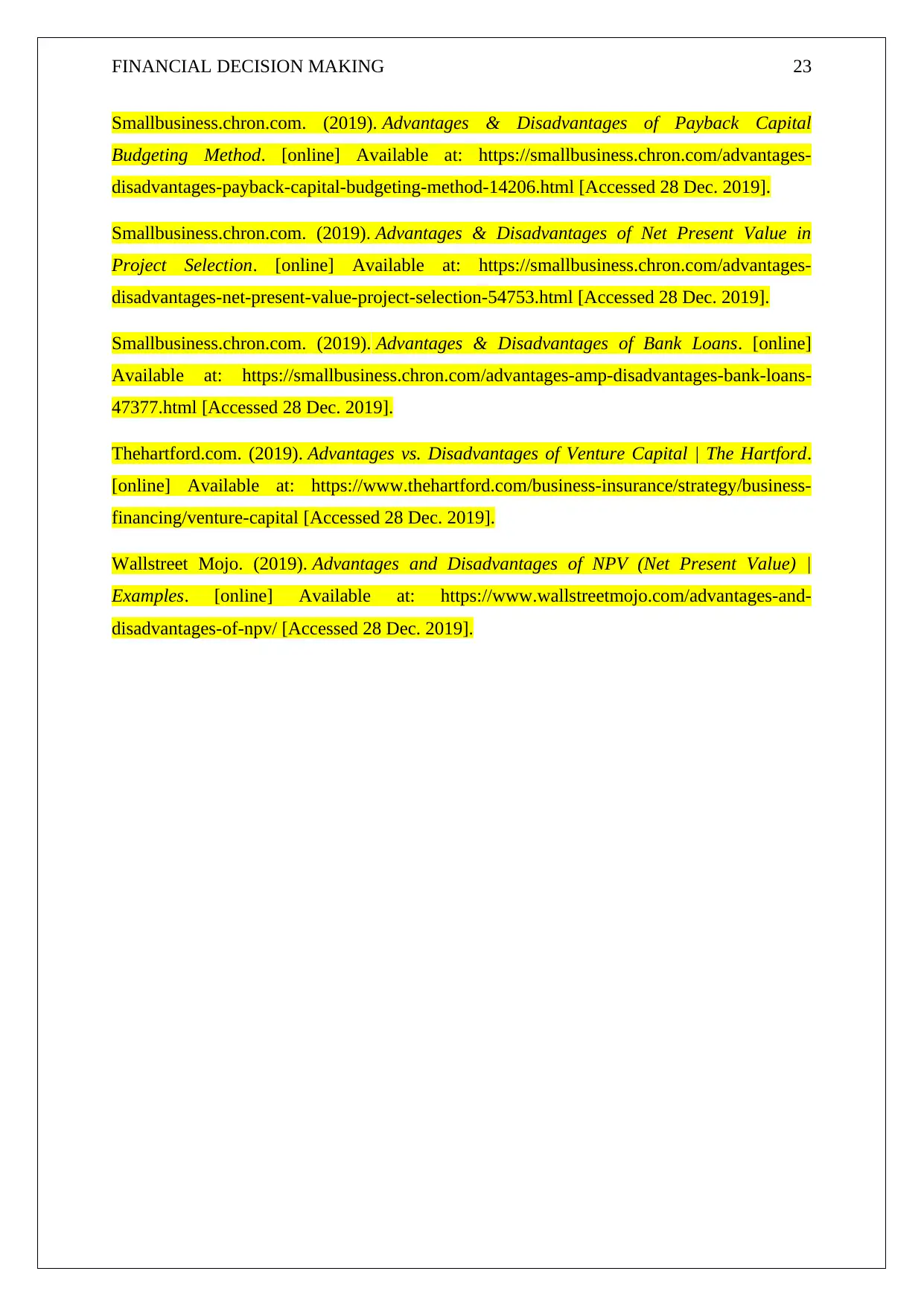
FINANCIAL DECISION MAKING 23
Smallbusiness.chron.com. (2019). Advantages & Disadvantages of Payback Capital
Budgeting Method. [online] Available at: https://smallbusiness.chron.com/advantages-
disadvantages-payback-capital-budgeting-method-14206.html [Accessed 28 Dec. 2019].
Smallbusiness.chron.com. (2019). Advantages & Disadvantages of Net Present Value in
Project Selection. [online] Available at: https://smallbusiness.chron.com/advantages-
disadvantages-net-present-value-project-selection-54753.html [Accessed 28 Dec. 2019].
Smallbusiness.chron.com. (2019). Advantages & Disadvantages of Bank Loans. [online]
Available at: https://smallbusiness.chron.com/advantages-amp-disadvantages-bank-loans-
47377.html [Accessed 28 Dec. 2019].
Thehartford.com. (2019). Advantages vs. Disadvantages of Venture Capital | The Hartford.
[online] Available at: https://www.thehartford.com/business-insurance/strategy/business-
financing/venture-capital [Accessed 28 Dec. 2019].
Wallstreet Mojo. (2019). Advantages and Disadvantages of NPV (Net Present Value) |
Examples. [online] Available at: https://www.wallstreetmojo.com/advantages-and-
disadvantages-of-npv/ [Accessed 28 Dec. 2019].
Smallbusiness.chron.com. (2019). Advantages & Disadvantages of Payback Capital
Budgeting Method. [online] Available at: https://smallbusiness.chron.com/advantages-
disadvantages-payback-capital-budgeting-method-14206.html [Accessed 28 Dec. 2019].
Smallbusiness.chron.com. (2019). Advantages & Disadvantages of Net Present Value in
Project Selection. [online] Available at: https://smallbusiness.chron.com/advantages-
disadvantages-net-present-value-project-selection-54753.html [Accessed 28 Dec. 2019].
Smallbusiness.chron.com. (2019). Advantages & Disadvantages of Bank Loans. [online]
Available at: https://smallbusiness.chron.com/advantages-amp-disadvantages-bank-loans-
47377.html [Accessed 28 Dec. 2019].
Thehartford.com. (2019). Advantages vs. Disadvantages of Venture Capital | The Hartford.
[online] Available at: https://www.thehartford.com/business-insurance/strategy/business-
financing/venture-capital [Accessed 28 Dec. 2019].
Wallstreet Mojo. (2019). Advantages and Disadvantages of NPV (Net Present Value) |
Examples. [online] Available at: https://www.wallstreetmojo.com/advantages-and-
disadvantages-of-npv/ [Accessed 28 Dec. 2019].
1 out of 23
Related Documents
Your All-in-One AI-Powered Toolkit for Academic Success.
+13062052269
info@desklib.com
Available 24*7 on WhatsApp / Email
![[object Object]](/_next/static/media/star-bottom.7253800d.svg)
Unlock your academic potential
© 2024 | Zucol Services PVT LTD | All rights reserved.





